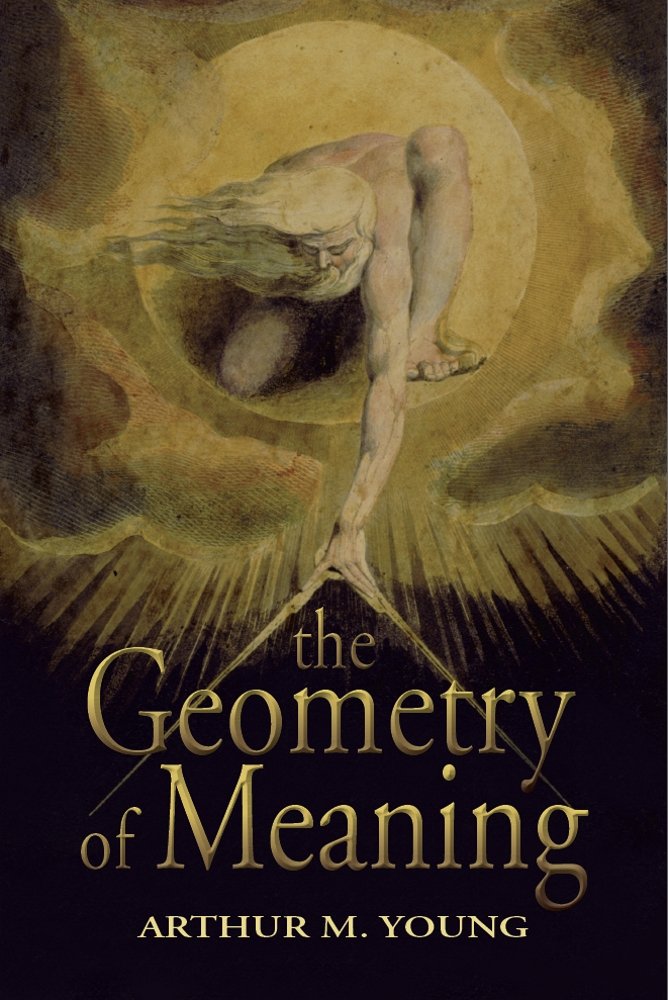
I have discovered the joy of learning Arthur M. Young's remarkable insights. I have not read his books yet, but stumbled into his online writing recently, and realized quickly how he is a brilliant intuitive -- indeed he has an exceedingly rare way of seeing the world, with deep insights into the nature of reality that I recognize immediately, partly because his insights overlap my own in multiple areas.
Some points I recognize because they match ideas evolved through years of contemplation, but other things he says are entirely new, incredibly deep, and very well-structured, due to his math and engineering background. I'm startled by how profoundly he discusses the geometry of meaning, which I've been studying partly as an aspect of my research into artificial intelligence.
If you scroll up in my weblog, you'll see Arthur M. Young's insights overlap my own thought experiments posted recently (only a few days ago), on "the meaning of meaning" and "the (ternary) will to meaning."
I think it was his insight into the right angle which caught my attention first. I had long ago discovered the central importance of the word "right," and its ancient relationship to words like "righteous" and "correct" and "reign" and "rex" and "regular" and "recht" -- and the list goes on and on -- and how it is contrasted with other words (i.e., if left=sinister, what makes right=right?), and how the word "right" is talking about something that's hard to put into words, or something which we used to understand better than we do today.
Well it's not hard to put into words now. As soon as I saw that Arthur M. Young had very simply described the essential geometry of a righteous judgment, I stopped everything and started listening very carefully to all that he's saying, only to discover that was just the tip of a great iceberg. Why haven't I encountered his insights before now? Many, many more people need to know about them!
So I've been going through his website material, which is thankfully presented in great detail, and he has such a beautiful mind. I have now watched with rapt attention three of his videos. As a longtime writer and editor, my preference is to read such material, rather than watch a video, but I'm poor and can't always afford books, and I don't like how Amazon treats their employees, &tc., so I started watching the videos.
Some of the points he makes are deep enough that I found myself rewinding and replaying several times -- which is one of the key reasons why I prefer to read. So I pulled down the auto-generated transcripts from YouTube, then edited them, while watching the videos, in order to put in sentences, capitalizations, and punctuation. Now I can go back and read as I am used to doing. I took screenshots along the way, whenever he was referring to the diagrams. This ended up being a great way to study what he was saying.
The videos are quite simple in presentation: it's just Arthur M. Young, sitting in a chair, talking, mostly, although every now and then he turns to a whiteboard and draws diagrams. At points, it would help to have read his books, but for introductory purposes, the presentation is quite good as is.
I understand the material below is protected by copyright; my purpose here is to have it easily accessible for when I need to refer to it as I continue studying the ideas herein. (In other words, I can scroll through this whole long post or use "search" to find a given topic within seconds, whereas doing the same with a video takes much more time.) Since posting it in the following manner on my weblog also makes it available to the whole world, I understand I need to ask permission for whether it is okay to publish it like this, or if I should make it password protected for my own study purposes only, or some other alternative. I'm working on that, and may change how this is presented shortly.
Below is a transcript of these two videos, and the next post covers his "Why Seven?" video:
- ARTHUR M. YOUNG: GEOMETRY OF MEANING PT. 1 of 2 (TEACHING SERIES) (YouTube)
- ARTHUR M. YOUNG: GEOMETRY OF MEANING PT. 2 of 2 (TEACHING SERIES) (YouTube)
The Geometry of Meaning
The subject of this session is meaning. Now you may be aware of a book that came out about 30 years ago called The Meaning of Meaning. But I never felt that this really got anywhere. To say "the meaning of meaning" is to invoke the circularity of all definition. If we want to really get to the nature of meaning we have to get some other reference.
When I first stumbled on the idea that meaning was angle, I was quite encouraged by the fact that I found that the Egyptians had said this thousands of years ago: "All meaning is an angle." Now this can be brought out, for instance, suppose we state: "Well, my opinion is diametrically opposite yours."
When I say that, I invoke a geometrical concept: The diameter. Two points are diametrically opposed.
Or we can even carry this out: we think of two contestants such as in a tennis game, or even in a court case: the two contestants are representing opposition. Now the judge takes a position that's not halfway between because that would be nothing. He takes mediating -- he has the power of judgment -- so it's a different power from what the contestants have and can be represented as a right angle. If that right angle is leaning over toward one side, then the judgment would not be fair.
Well then we could ask what what is a just judgment? We look up the word "just" and it says "right." A just judgment is a right judgment. Well what is a right judgment? And then you look that up and you find it's a just judgment.
But if you jump over into geometry, the word "right" also means a right angle. So we can converge on our subject by saying: That which judges the opposition -- that which mediates the opposition -- in order for it to be right, it must lean neither to one side nor the other. It must be exactly perpendicular. This leads to the title Geometry of Meaning, because by recognizing that there are -- for any dichotomy -- there is another dichotomy that cuts across it at right angles and mediates it. We also invoke the concept of a right angle and hence of angles and geometry. This is the basis of the book that I've entitled The Geometry of Meaning.
To get into this subject we can start with the problem of the knower and the known. I have a simplified diagram here which depicts the knower as an eye and the known -- in this case as a triangle.
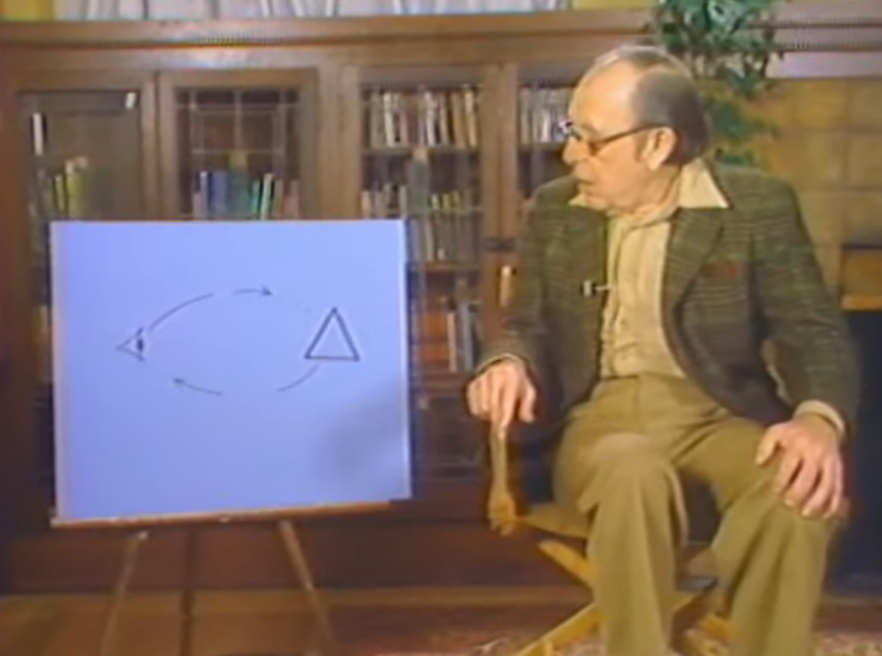
Now, there are different kinds of knowledge that we can draw immediately from this diagram. First of all, the knower, represented by the eye, is looking at a triangle. What is a triangle? A triangle is three equals -- an equilateral triangle -- three equal lines joined. Or three points joined by lines. The definition of a triangle is self-contained. It doesn't matter whether the triangle is near the person or far away or whether the person likes the triangle. The definition of a triangle stands. It can be stated and formulated: Three lines or three points joining one another.
Now on the other hand there are other relations or relationships that the knower can have to the triangle. He may say: "well I don't like triangles." Or "triangles remind me of the eternal triangle, marriage condition: 'husband wife and lover.'" Or "that triangle..." It's interesting to extend all these things that are not contained in the triangle. In other words: "I like the triangle," the one I first mentioned... but you could also talk about "the size of the triangle." because if the triangle is very close to the eye or if it's very far away, this difference is: "How big is the triangle?" The bigness of the triangle is not an objective factor. It's something that has to be related ultimately to the self. See if you were alone in the universe you couldn't say how big you were. You have to have some other comparison object. Now this relation to the triangle that the self projects on the triangle, which includes liking and disliking, but also scale, is what I call projective, as distinct from the objective relations of the triangle to itself.
On the other hand there's another set of relationships which proceed from the triangle to the knower. In other words you could say: "well that's not a perfect triangle, there's a little bend there," or "there's a dot there, so it's not perfect," or "I measured the sides and they're not exactly equal." These are data which the object conveys to the knower. They are objective data as against the projective, which the knower -- so to speak -- invests in the image.
Now that gives us three categories: the relationships that are self-contained, that is: Ff the triangle to itself; the relation of the knower to the triangle -- that is projected by the knower on the triangle; and the relations that the triangle conveys to the knower -- these are objective because they're coming from the object.
Is there any other category? You see we have the triangle to itself, the knower to the triangle, the triangle to the knower. Well there must be a fourth category, which is the relation of the knower to himself. That doesn't make any sense, but when you think of it applying to the triangle, then it is the relation that the knower creates for the triangle.
In other words what purpose does he use it for? He might use it as an emblem. He might use it as a geometrical proof. He might use it as the thing you hit in the orchestra that makes a noise. What is the purpose of the triangle is something that is completely separate from the object.
See, for instance, while making these charts, I used a clock to draw a circle. Now there's nothing in the clock that says "I am a compass." The clock didn't contain the purpose. It was I that used the clock for the purpose.
This fourth category then becomes the purpose for which you use the object. It is still a relationship and it is still connected with the object although it is not an objective property. It's a projective property.
Now we had already a projective property in that the knower said he didn't like triangles. So we've got two projective properties. We also have two objective properties: The self-contained relations of the triangle, and the data that the triangle -- as object -- conveys to the knower. Those are both objective. So we need another distinction. We need to separate the two kinds of projective and the two kinds of object.
Fortunately that's possible with a single distinction. When the knower says "I don't like triangles" he's making a generality. On the other hand if he proposes to use the triangle as an emblem for the Phi Beta Kappa or whatever it is -- the triangle club -- this purpose is particular, whereas his dislike of triangles may be general.
In a similar fashion, the objective properties of triangles are general. That's why you can define a triangle or why the word triangle covers a great number of configurations of triangular shape. But when I said this one has a bend in this side, or a little mark there, that's a particular. So there are objective particulars about this triangle and general... wait a second... now I'm getting mixed up. Both of these are objective, but the particular objective is what comes from this particular triangle that has been drawn here. The general objective is the definition of the triangle itself.
So that makes it possible to think of two dichotomies. So we began with a dichotomy of knower and known -- projective and subjective -- but we further distinguish with particular and general. If we make those two dichotomies at right angles to one another, we're launched on our geometry of meaning.
Now these are the four kinds of relationship. They have many many exemplifications. One that's perhaps the most well-known is Aristotle's four causes. If you recall the Aristotlean causes were: the material cause, the formal cause, the efficient cause, and the final cause. You'll have to just keep them in mind and try to assign them to those four kinds of relationship.
Think for instance of the formal cause. That means the form. The form of the triangle is its definition, its shape, you might call it the blueprint of the triangle. Generally the four causes are related to a table, in which case the formal cause would be the blueprint of the table.
If we continue with the table, the material cause would be the wood that went to make up the table. The efficient cause would be the carpenter making the table using the blueprint and using the wood. But he forms the wood according to the blueprint and thereby combines the formal cause and the material cause into the efficient cause.
What's the final cause? The final cause is what brings the table into being. That's why it's called final, namely the purpose of the table, which would be something to put things on. We can play around with this. I'm going to be coming back to it.
Maybe I better make a few more examples. In the book I use an elephant. Of course the textbook will define the elephant as a mammal, of such and such a family and genera, it would talk of proboscis. This is the definition that would apply to any elephant, that you might go out in the jungle or go to the zoo and find. And then you meet a particular elephant and you are surprised how hairy he is. You hadn't in the definition anything about hairiness, or you might be impressed with the warm breath blowing through the trunk. These are sense data which you get from the actual object.
On the other hand you might have, let's say, convictions about elephants that they were ferocious beasts. Then you might actually find an elephant and find that he was very gentle. In other words it wasn't true. Well that's often characteristic of these projections: they're based on some previous memory or even some false data, so that you project qualities onto objects that they don't actually possess.
Now when we come to the purpose or final cause of the elephant, well what are we going to do with an elephant? We might use them in a circus or we might use them to as a mascot for the republican party. Or we might use them as a beast of burden, or as a subject for biological studies. There are a whole variety of purposes of the elephant and that would be entirely up to us.
There are other delightful examples. I'll leave one for you to think about and then pass on. What are the four aspects of a map? In other words, given a map, what would you need? What else would you need to know if you were lost? I won't try to cover that but it's something to think about.
Now as I said these are four types of relationship. But we can also find that there are other things beside relationship. For instance, there are actual or actual actions or -- let's just call them actions -- for which, in which case, you're doing something.
To illustrate this, I can show it with a pendulum. Here I've made a pendulum. I can swing the pendulum (swings pendulum, a weight on a string). Now in order to completely analyze this swinging pendulum, we have to go through certain mathematical procedures, so forgive me. But you notice it swings from side to side. Also, the speed is varying. Now let's try to analyze that.
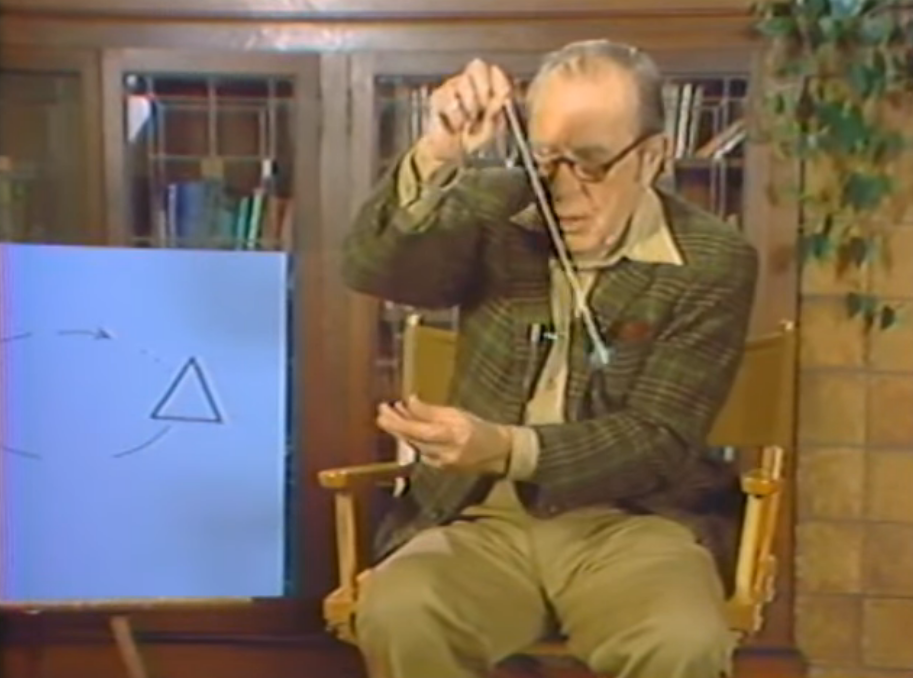
Suppose I adopt the convention that this is positive (stops, then swings pendulum from his right to left). That's a positive position to my right. This will be a negative position. Now if I let go in the positive position, it swings back, reaches the negative position, and then comes comes forward again.
At the positive position, its velocity is zero. At the negative position the velocity is zero. In between, the velocity is a maximum.
Now there's another factor here, acceleration. Acceleration is the rate at which the velocity is changing. If we we can note first of all that when the position is positive -- that's here to my right -- the acceleration is negative because it's trying to go back.
We can also recognize that on the first half of the swing, if we call this velocity negative, when it comes back the other way, the velocity will be the reverse of that, so it'll have to be positive.
So it's going from a positive position to a negative position, from a negative velocity to a positive velocity, from a negative acceleration, and there would be a positive acceleration over here.

Now the way to show this on a diagram is to represent these three categories that I've described, which are technically represented by "L" for position, see? Now this was my extreme right, so the diagram is backwards for you. Anyway this would be where I started, where the position is positive. This (L/T) would be the swinging through velocity. Velocity is position divided by time. This (L/T^2) would be the negative of the position, but it's where the acceleration -- which is L divided by T square -- where the acceleration is positive.
Now you can think of the pendulum just swinging between those two extremes, going from positive position to negative position, from negative acceleration to positive acceleration. In other words acceleration and position are diametrically opposite. See position and acceleration are diametrically opposite. Velocity is represented as right angles to the two.
Now we could say: "Well this (L/T^3) is the negative velocity," but since the negative position has a positive meaning as acceleration, we might ask: "What is the positive meaning of the negative velocity?" In other words what's this up here (L/T^3)?
Now watch what I do. I accelerate and decelerate. (Starts and stops pendulum again) I control. I can control the thing by moving this with itself. I can control the whole operation from what would be this fourth point.

I give this point the meaning, or the name, control. I hope you can read it. It says length divided by T cubed. Now let me see... I know people get into a paralysis when they see a formula but this is a very simple thing and it's been enormously productive.
If we go back into Greek times there's a story about Zeno. Zeno proposed the proposition that the arrow couldn't possibly be moving because at every moment it's at rest. No matter how many moments you add up you won't get movement. In another form of the Zeno paradox, he took the example of a race between Achilles and the tortoise. The tortoise had a head start and Achilles, said Zeno, could never catch the tortoise because in the first instant he'd be getting to where the tortoise was. And in the next instant -- during which time the tortoise would have moved ahead... Let's say this is Achilles and this is the tortoise. So Achilles moves to here meanwhile the tortoise has moved to here. Well when Achilles gets to here the tortoise has moved to here. And when he gets to here, you move to here. So Zeno said the Achilles could never catch the tortoise (laughs). Well it's ridiculous. But the point is that the rational mind can't cope with that.
It wasn't until Newton invented the calculus that you had a formal description which would get past this so-called paradox. Newton invented the formula for velocity. Seems very simple to us now, we talk about velocity all the time with all these cars and missiles and things... But just the concept of taking length or position and dividing it by time -- that's what velocity is -- miles -- that's a distance per hour or feet per second. The "per" means it's divided by. So velocity is distance per time.
At the time that he introduced this concept, Bishop Berkeley, who was otherwise a very intelligent person, said this was absurd. Of course Newton had to talk about very small increments in order to talk about the rate of change on a curve. Berkeley said that was ridiculous because the ratio of infinitesimals was doubly impossible: Infinitesimal was impossible, and the ratio of infinitesimals was still more impossible. Well that's not right. It's a matter of getting used to it but people now accept that a ratio of infinitesimals can reach a limit and that limit is the velocity of that object at a point.
Now I'm going into this detail -- to encourage you to stay with me on the formulas -- because it was the formula that got past the paradox.
Newton also talked about the rate at which the velocity changes. Suppose you say "Well, my Volkswagen can accelerate to 60 miles an hour in 10 seconds." That would be pretty good for a Volkswagen, but let's assume. You notice that I've said time twice. I've said per -- it goes 16 miles per hour per 10 seconds. In other words I've divided by time twice. That's what the T square under the L means there.
Now for some reason -- well for very definite reasons really, but until they were enunciated, there was no reason -- Newton didn't carry it any further. I'm talking about the possibility of taking one more derivative and saying "What is the change of acceleration?"
Now... (laughs) it's such an obvious thing, and everybody's doing it all the time, because: how else do you drive a car? It's only by changing the acceleration that you can control the car. You put on the brakes or you push the accelerator, and even steering, is a form of changing the acceleration, because you're changing the direction of velocity. That means a change in velocity, and change in velocity is acceleration.
Now this is much like many of the human predicaments. We do these things instinctively but the difficulty of stating it in formal language, making it part of our know-how, is quite another step. We know how to walk, run, so on, long before we had the formal equations for speaking of velocity acceleration and control.
Now, why was it that Newton left out the control of acceleration, this fourth one? I really don't know whether he knew about it or not.
But the reason science leaves it out is because science deals with the closed system. See when you're pushing the accelerator, you're feeding new energy into the car and that is what changes its speed.
You're changing the rules so to speak. You're interfering with the closed system of the -- let's say the billiard ball, the machine, what have you -- you're doing something from the outside, and naturally there would be no point in having machines if you couldn't control them.
But for some reason, for the reasons of giving the rational mind what it wanted... The rational mind wants to explain everything. So science was insistent that, in order to explain things, you mustn't interfere with it, you must let it alone. That was fine but in the process of letting it alone they forgot that that leaves man out of it. So now they want to go a step further and say there is no man in it. We've got all these laws worked out, and we can't have someone stepping in and changing them.
Well that's getting the cart before the horse, because the reason the laws are worked out is so that you can step in and use them. Otherwise why make the machine at all? This is such an obvious point that I feel a little embarrassed talking about it and yet I've never been able to convince a physicist that this is a valid step, beyond the acceleration that he knows about.
This factor is recognized in aviation. It's called jerk. But that designation is largely because a black box is used in a control system, and it has to be either on or off. So it results in, essentially, jerk, whereas when you drive a car you can apply the brake smoothly or you can apply the acceleration smoothly. It doesn't need to be a jerk.
Now if this system is correct, in other words this ratioing that I'm doing, which is equivalent to taking the derivative -- this is the first derivative, the second derivative, the third derivative -- well then we should be able to come around here and get to back to where we started. In other words the fourth derivative should be position.
Well then we have to ask ourselves, well what is it that controls the control? I ask this in seminars and I'm surprised how few people can answer it. You get in your car and you drive, you keep on driving, steering etc etc -- what is the thing that controls the way you control a car? Well, when you get to your destination, you put on the brakes and stop the car and get out. Now what is destination in terms of these... what I will now call "measure form," because that's their name in physics?
Destination is a position. In other words -- it's not the same position you started but it's the same category. The destination isn't a velocity, it isn't an acceleration, it isn't a control, it's a position.
Similarly if you had a remote control missile, or a target-seeking missile... See the missile is trying... well the missile is just shooting through the air, but you have a control device on it so that the target is sensed. It picks up some kind of image of the target and tries to home in on it. If it's going too high it'll come down, or too low, to go up. It homes in on the target. The target is again a position. A position in space.
So this is a very important step. We've shown that the derivative -- that is this business of going from position to velocity to acceleration to control -- takes us back to position in four steps. It is therefore what's known as a four operator. A four operator means something that returns to the start in four steps. It doesn't mean that there aren't higher derivatives, but the higher derivatives fall on these categories again.
For instance, suppose this guided missile that I was talking about was an airplane and the airplane is trying to get to this target. Now suppose I'm trying to intercept this airplane with another airplane, and I come along and say "Well he's going to that target. I'll shoot toward there and be able to intercept him, gun him down before he gets there." Well then we get into a new ball game because we get to the fact that the pilot of the other airplane may anticipate my trying to intercept him, so he will pretend that the target is here when it's really over there. A similar thing would happen with boxer. A boxer feints. He makes as if to hit with the right to the jaw and instead hits with a left to the stomach or something. But you still are using this diagram. If the factor of deception is involved then you have to go around again.
Well what have we been talking about? These are the four kinds of action. The four kinds of action are related to the four kinds of relationship. But they're two whole separate families. I want to show how that kind of relation can be distinguished from the kind of relation I've been making between the members of the fourfold, that is the different angles.
Here I have a diagram, I mean a list of words, and the formulas, that were mentioned in this diagram.

These... see here we have L, L over T, L over T square and L over T cubed. Those are the four actions. Now what I'm talking about in physics would be called... these would be called the measure formula. These are sort of the fundamental ones. But there are other measure formula and there's a new set I can get to by multiplying each of these by mass.
Perhaps the most familiar one is the third (L/T^2). If I take acceleration and multiply by mass I get force.
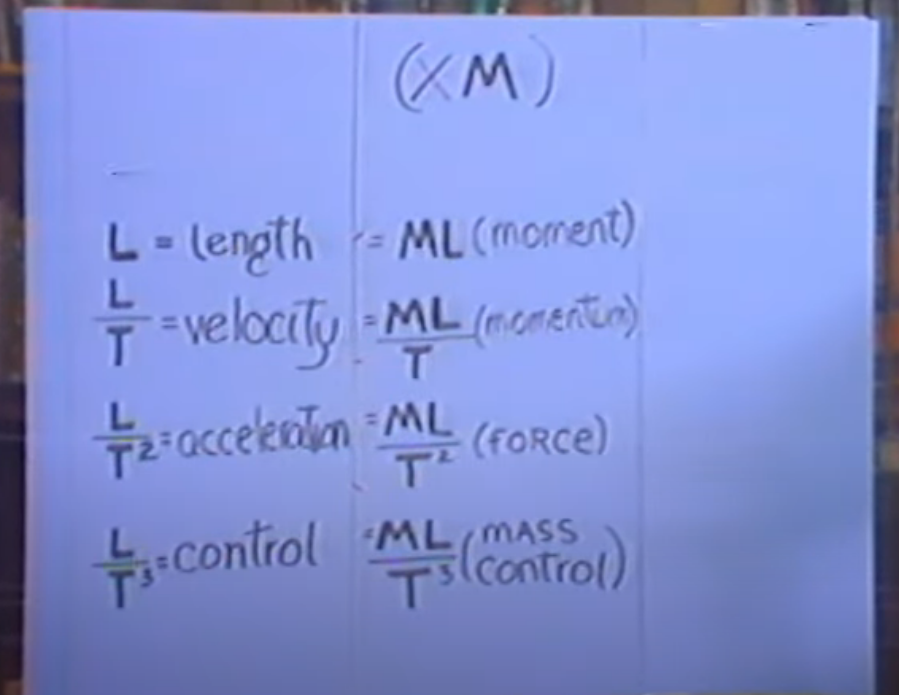
Now see, on the earth's surface where we are, there is the acceleration of gravity, but you're only aware of that acceleration of gravity through forces. The force comes about because of the weight.
For instance, I lift a light object, and compare that with lifting a heavy object, the difference would be the mass. But the gravitation at the earth's surface hasn't changed. The force has. So force is mass times acceleration.

In a similar fashion, velocity. Velocity when multiplied by mass creates momentum.
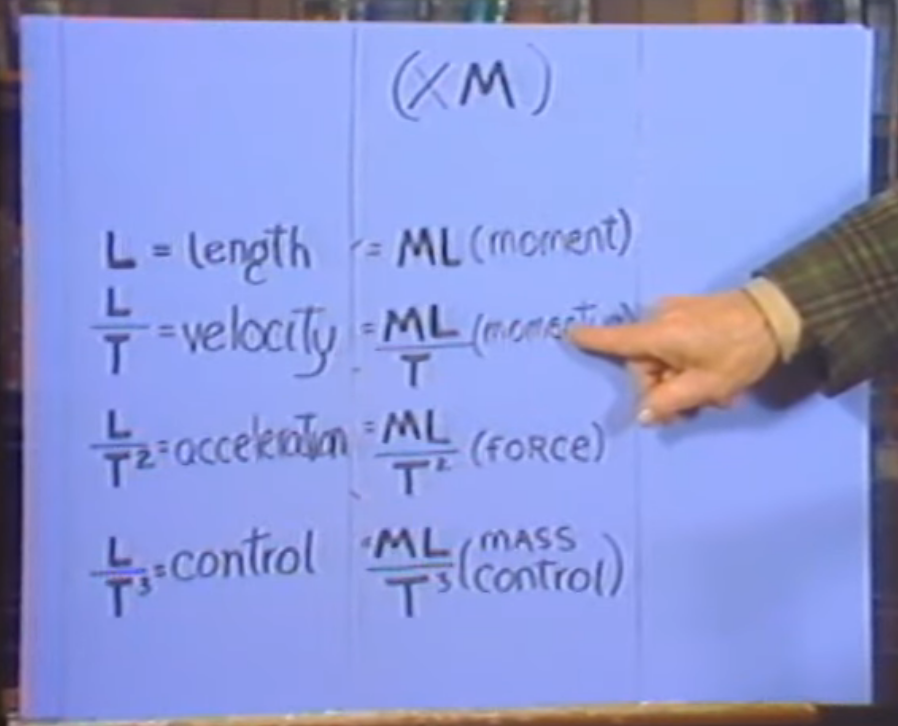
Thus we can speak of the momentum of a car hitting a telegraph pole. If a feather had blown against hit the telegraph pole at 60 miles an hour it wouldn't have damaged the telegraph pole. But if a two-ton truck hits the telegraph pole at 60 miles an hour there won't be much telegraph pole left. The momentum in other words is proportional to the mass of the truck.
Now -- this is a little more abstract -- this is length of course. Suppose I have a lever. I want to pry up a stone. So I have a crowbar and I shove the crowbar under the stone. That doesn't lift the stone. I have to put my weight at the end of the crowbar and push it down to have enough moment... leverage... moment is leverage.

It's mass times distance. Now if I couldn't lift the stone with -- well I remember last summer we were trying to get the roots from a tree that had fallen down, and even with a crowbar I couldn't lift the roots. So at my weight -- I couldn't increase my weight -- so I went and got a longer... not a crowbar, but I got a 20-foot beam, three by eight. Using that beam, putting a chain around the rope and around the beam and the pivot, then when I stood on the end of the 20-foot beam I could lift the root right out. In other words, moment depends on mass.
The mass in that case was my weight times the length either of the crowbar or the 20-foot beam. So you see how these things mean something different when multiplied by mass. This is the only one that's not referred to in the textbooks.
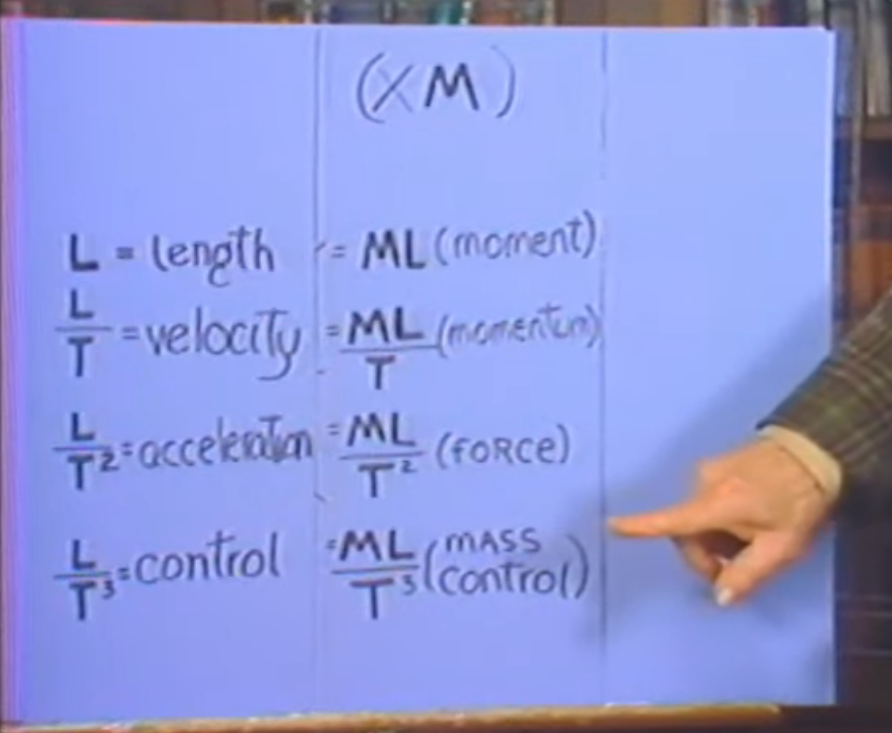
Remember control was not referred to in the textbooks. But when you multiply mass times control, you get this one that I call mass control. I think it has a name in aerodynamics. It's called power control, but that's not really correct. It's either force control or mass control. In any case the formula is ML over T cubed. That's the beauty of these formula: it doesn't matter what name they have. The meaning comes from the ingredients in the formula and that's why it's possible to have the science of moving bodies.
Often these formula get mixed up, especially when people are trying to invent things. They get force, power, and things like that mixed up. For example how is it possible for a hundred horsepower automobile to be stuck in the ditch and along comes one horse and pulls it out? So it isn't a question of horsepower. It's a question of force, and one horse can exert more force than a 100 horsepower automobile because the force is being exercised, or being exerted, at a much slower rate.
So the force can be greater for the same expenditure of energy. Now, speaking of energy, you see that is still -- that's not present -- in this is this list. Well, energy is on a third list that I want to show you here. We don't have the word energy, but we have work, which is the same thing. The preference for work was because it's shorter word. Work.

In other words, if I'm... what's the difference between this one and this one ("force" and "work")? See it's L squared. If I exert force for a distance I get work.
If I go upstairs, let's say 10 feet, and I weigh 150 pounds, then I've done 150 foot-pounds of work.
Now the next step from work is to talk about how fast can I do this? In other words, I divide by time, just as I did to get velocity. The rate of doing work.
If I go up 10 feet of stairs in one second and I weigh 150 pounds, how much horsepower is that? It's 150 foot pounds per second. Excuse me, times 10 feet: 1500 foot pounds in one second. That is about three horsepower.
It wouldn't be possible for me to get up 10 feet of stairs in one second. I can say that categorically, because the maximum a person can exert is -- over any length of time -- is about a quarter of a horsepower. The maximum would be three-eighths of a horsepower.
All of this was very important for this person who tried to fly across -- or who did fly across -- the English Channel under his own power. He had to get such an enormous span of a wing, and have it so light, and had to stay so close to the ground, that the quarter horsepower that he could exert was enough to keep him afloat.
Well I didn't really give you the whole picture here but what's happened is I've multiplied each of these by L and got a new set. From moment, I went to moment of inertia. From momentum I went to this action -- I'll be talking a lot about action. From force I went to energy or work, and for mass control I went to power.
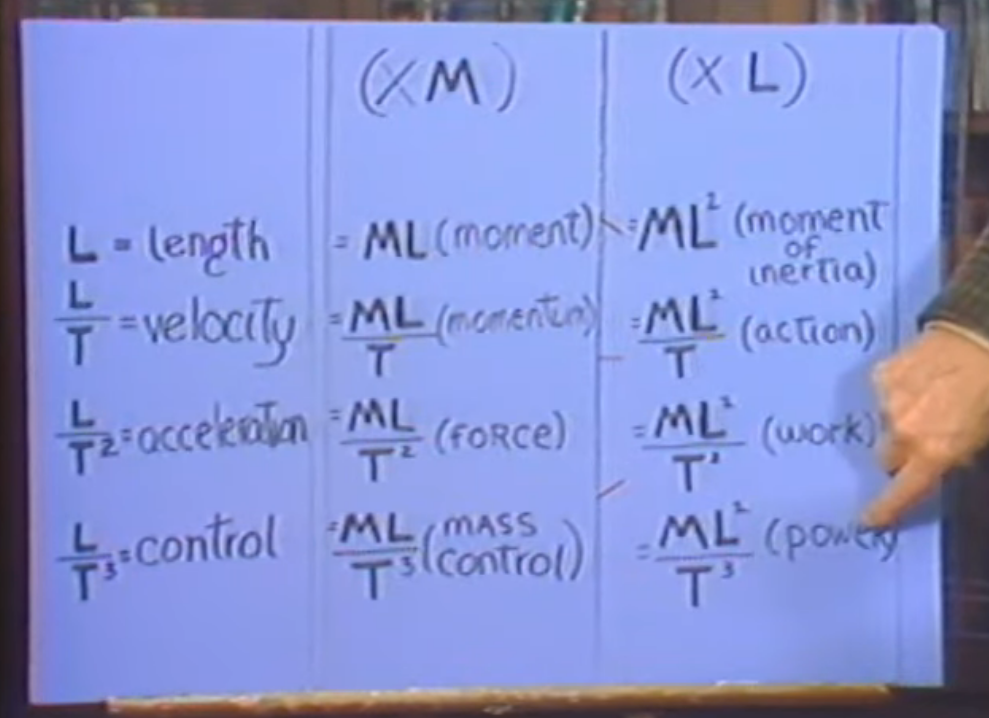
Now power is well recognized and will be -- this formula will be -- found in all the physics books, so this verifies the legitimacy of these, because they, like power, are third derivatives. So you can't rule out the third derivative on the grounds it's not in the books because this is the third derivative and it is in the books.
[At this point, the first video ends, and the next video begins]
Now we need to, as I said, put these together into one one totality, one schemata. We've got three sets of measure formulae. Realize that with these 12 measure formulae we can completely solve the problem of moving bodies. We have the entire vocabulary needed for the physics of moving bodies. Incidentally, we can even anticipate the famous formula E equal MC squared.

So that's exactly what this is because MC squared -- what's C? C is a velocity, i.e., L over T. We have here L over T squared. L squared over T squared. ML squared over T squared. That's MC squared. That is as I said before: energy or work. E. E, energy, equals MC squared. So the measure formulae anticipated this famous formula of Einstein.
Well how do we put them all together? Well that's very simple.
In this set since we went around in four steps. We were using time -- division by time -- as taking a fourth of a circle, so that when we took a fourth four times, we had completed the whole circle.
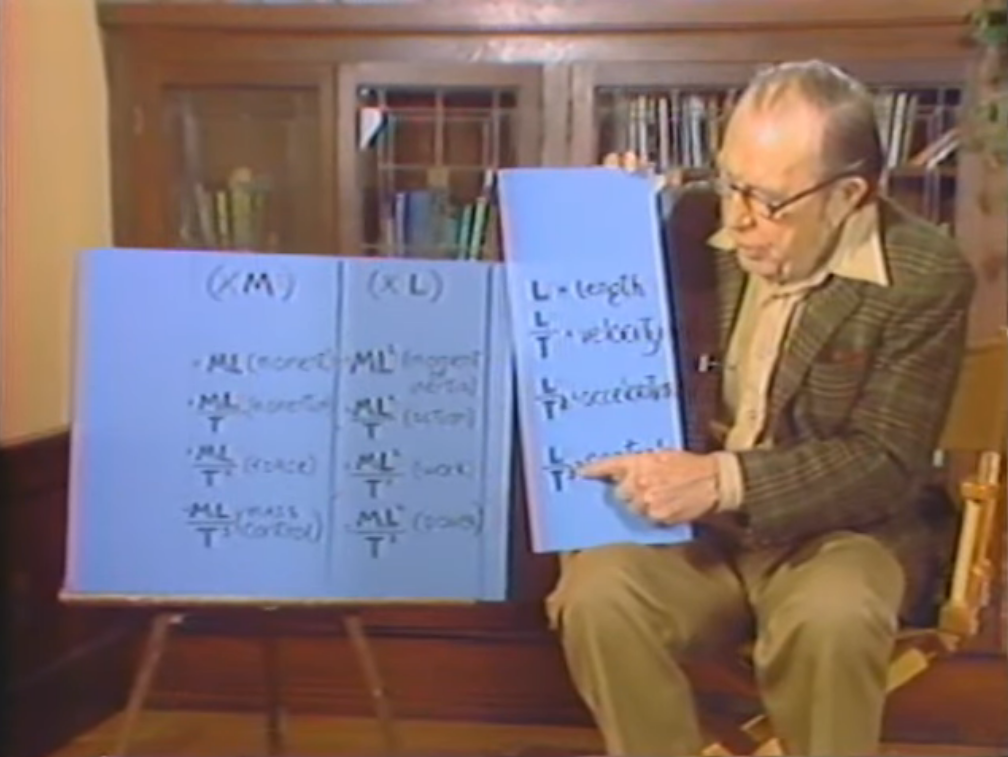
Now what I want to do is come to the next set which is this one. How do we get -- you see we have the first set here already -- how do we get to the set multiplied by M?
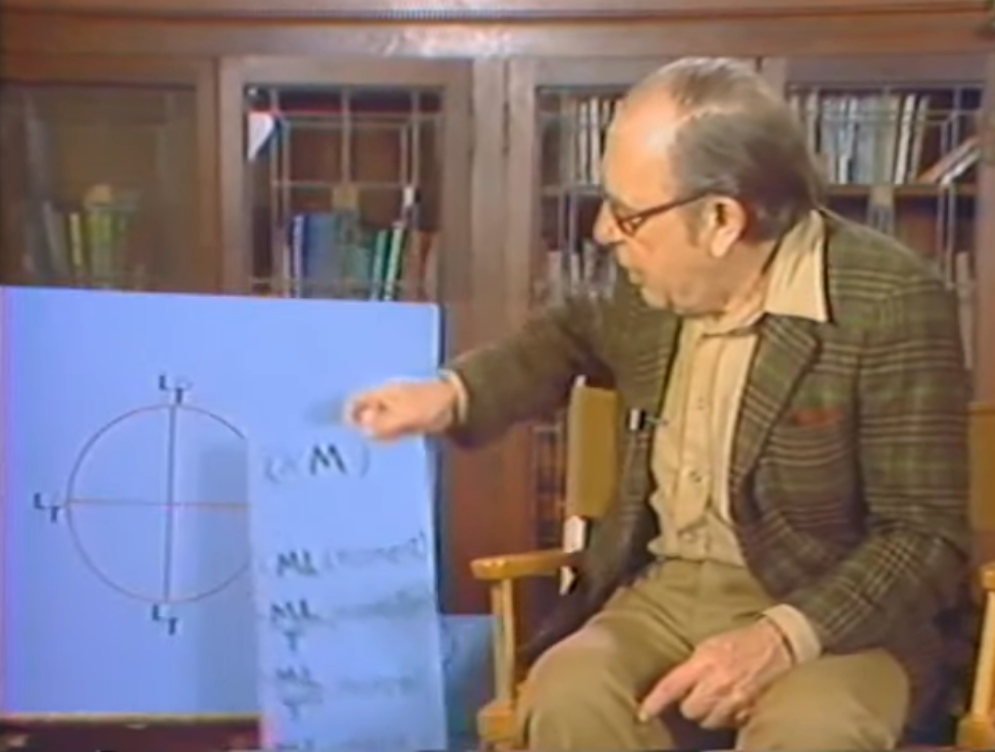
Now if we take M as 120 degrees, of course we can't be 90 because that would simply duplicate what we had before. This is 90.

So let's take 120 and get to a point here.
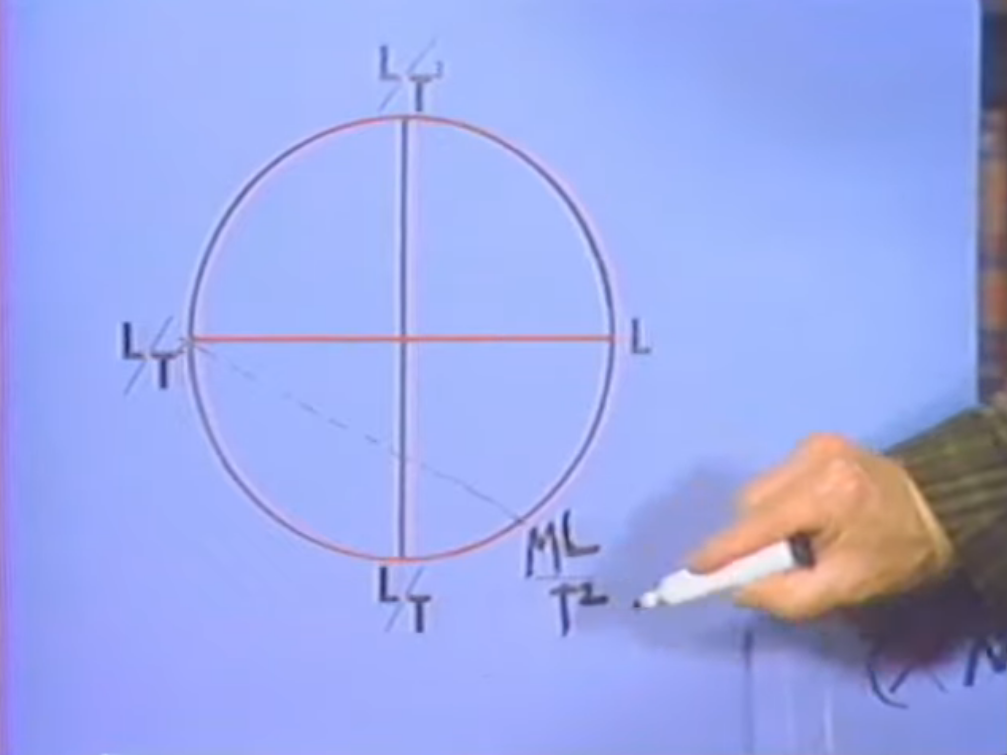
In other words call this ML over T squared.
Now I'll use the same rule for multiplying by M here and get -- this will be ML over T.

Same one here, ML.
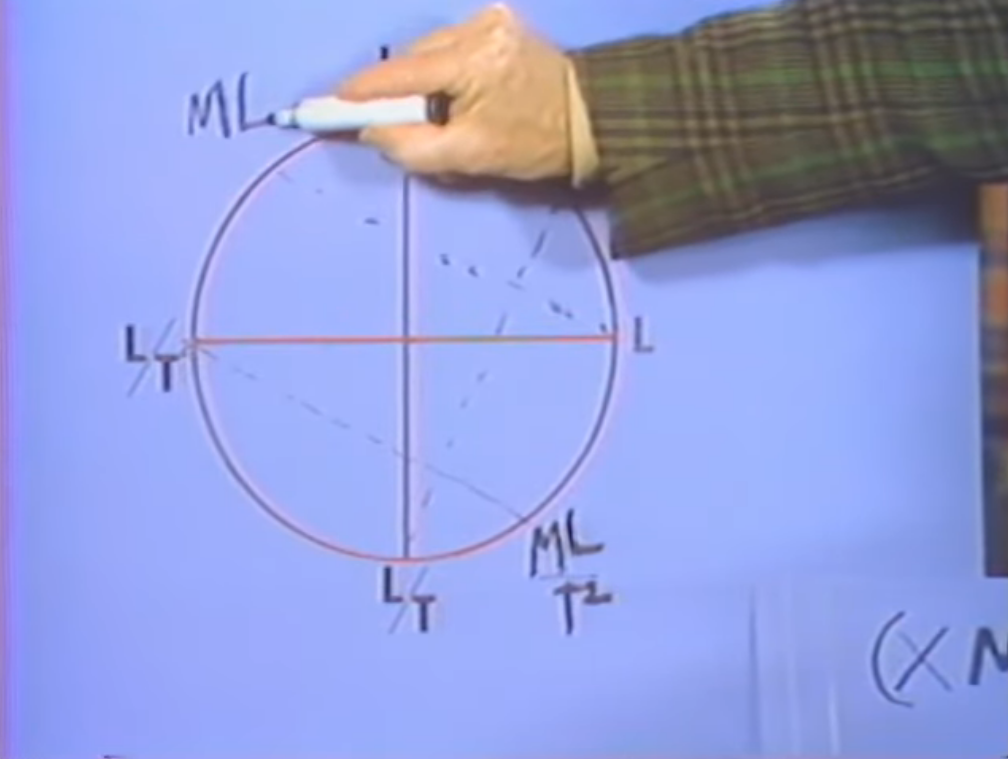
And the same here, M.
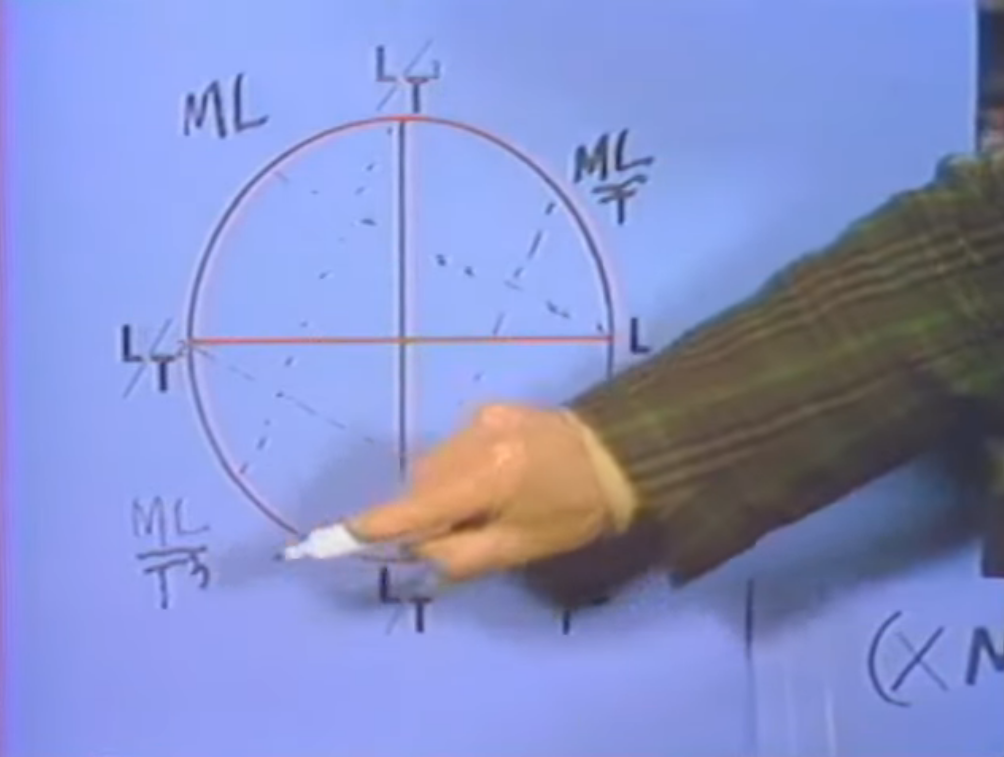
They all have ML, see, but this one is divided by T cubed.
I've added the second set. Now we need to put in the third set.
If I make the convention that L is 30 degrees I can fill those in. 30 degrees, see? I've gone 120 degrees, so since this is 180 there's 60 in here, so half of that will enable me to put this one multiplied by L which will be ML squared over T squared.
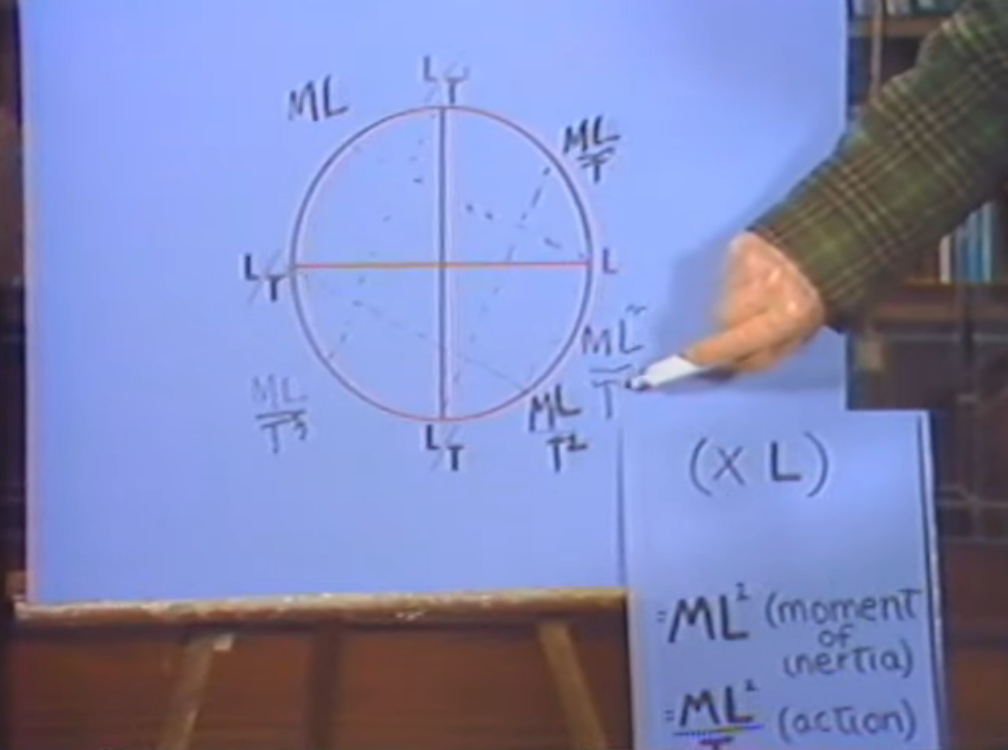
That's this one this one will be M L squared they're all ml squared. Now but this is over T this will be M L squared without any T and this will be M L squared over T cubed.

Now I've got the 12 measure formula all arranged in this circle and my convention is that T equals 90 degrees. Mass equals 120 degrees. L equals 30 degrees. That is what I call the Rosetta Stone because it enables you to translate the measure formulae of physics into English and this is my attempt to do that.
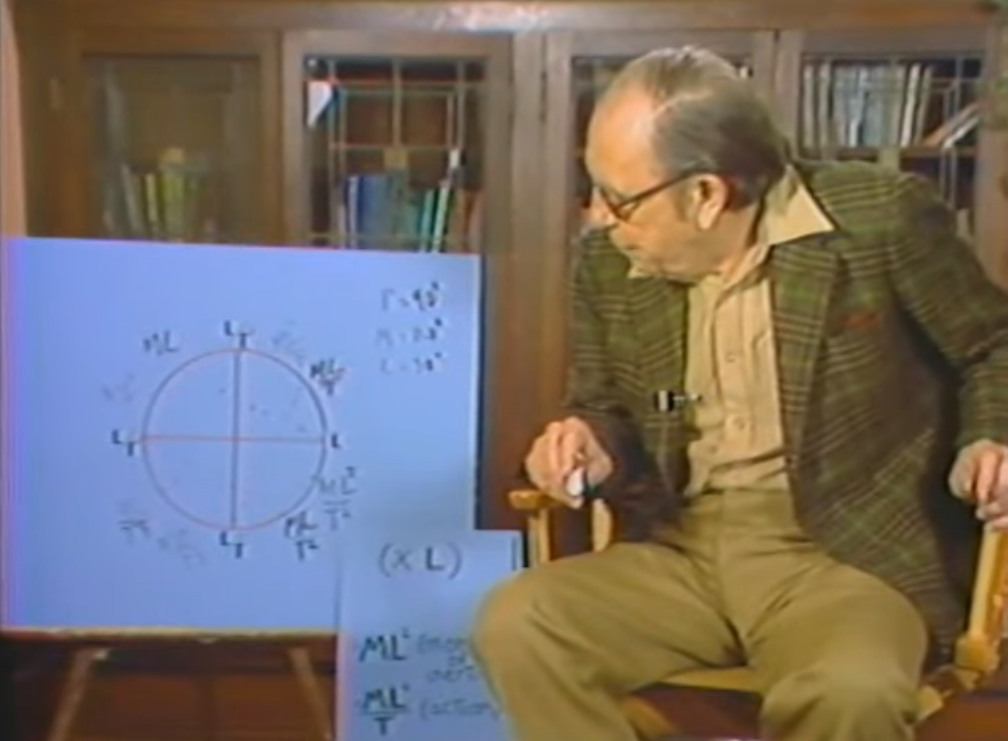
Now some of these the English words are going to be the same. For example, control stays control. Work can stay work.
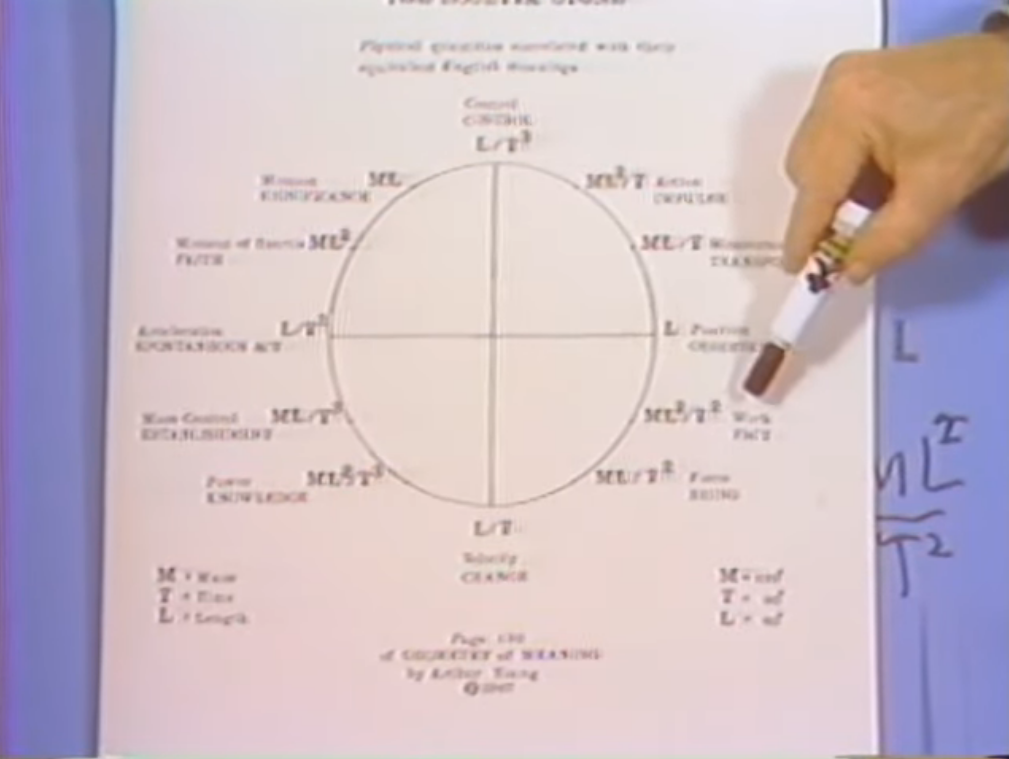
But for the purpose of further -- as you'll see further -- it's going to translate into, in fact I'm afraid this is going to be a little difficult... Perhaps I better go more slowly and perhaps I better follow a distinct order.
Let's go back to the first four that would be these and these remember I started with position.
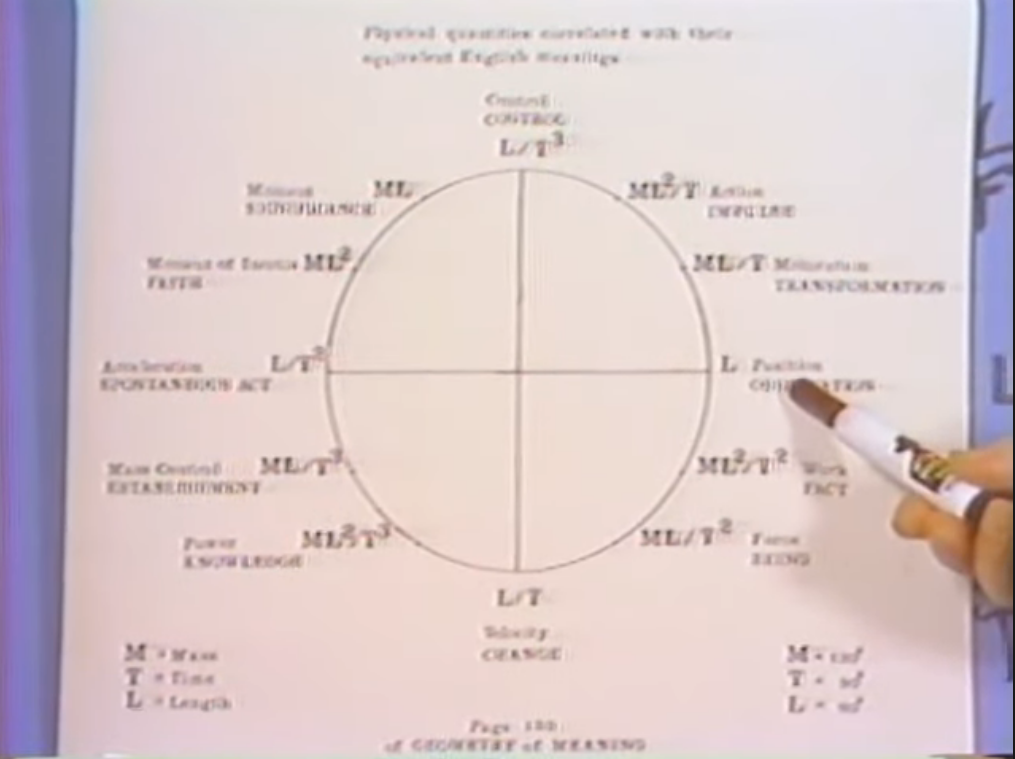
Well position is something you observe. So I'm going to use the English word observation there. Velocity is the rate of change.
Now in this in physics, it's through the change with respect to time, but let me take the liberty of referring to it as any change -- that is actually what Aristotle meant by change; he didn't mean velocity, he meant any change.
The rate of change, which, for the purpose of measure formula, was acceleration, becomes, in English... it's the spontaneous act. It's that which you do. When you jump... or when you change something. It's generally the start of things. Control, and the fourth of these four -- I can keep the same word. So much for the first four.
Now let's look at the second four. That was this set multiplied by M. Remember I started with force: that's the one that came from here.

When I multiply the acceleration by mass I get force. Well the English word for force could be being. It's just that that great thing that is there, that makes a person forceful, their beingness.
The next one, multiplying velocity by mass, which gives you momentum. Momentum is the way you transform things. You want to break the vase, whether you hit it with a hammer, or you're going to drive in the nail. Momentum, this impact, results in change because it really comes about because this -- it's not the same as force; the force is something that's being exerted -- momentum is that which makes things change, so that's why I call it transformation.
I'll show you in a minute another way you can check up on these relationships. We want to finish though.
Now observation, which was the third one, and which, when multiplied by M becomes moment, I translate that as significance. That's... well it's almost a pun, but it's a little better than a pun, because you say things of great moment, when you mean things of great significance.
But we also use the term leverage in just the same sense. You have a lot of leverage if you have significance in a situation. And it comes about in much the same way. It's not just mass, it's the distance multiplied by mass. The thing has more leverage if it has a longer reach.
It leaves only this one more which is not used in physics: multiplying control by mass to give mass control and I call that establishment.
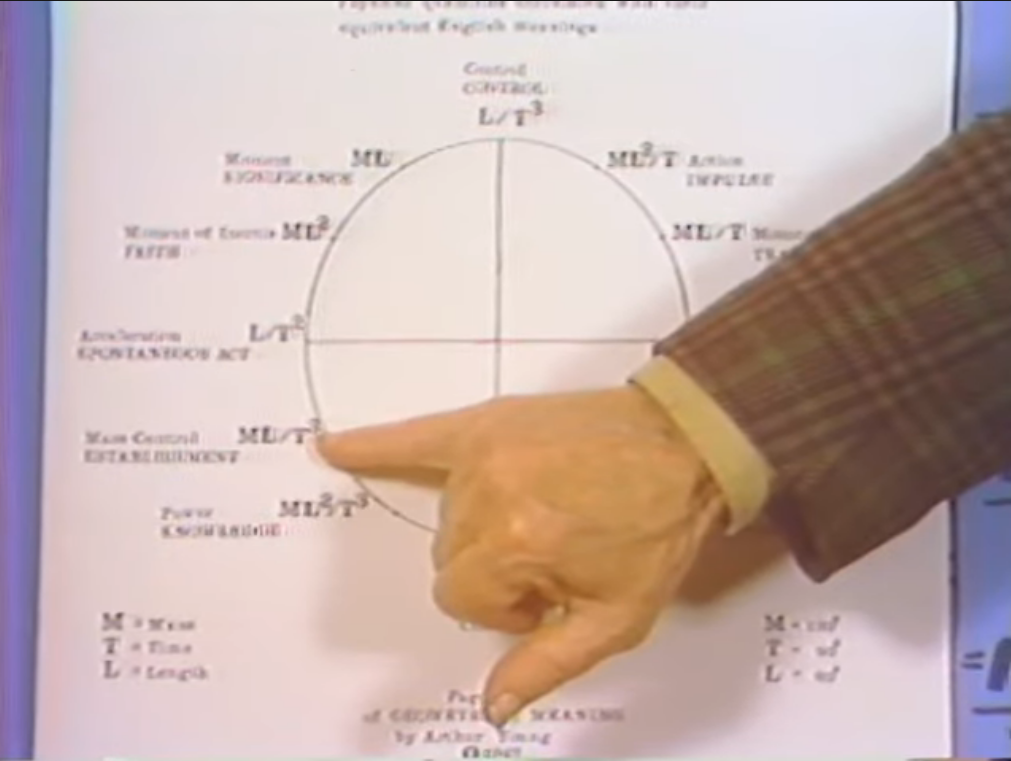
It's getting the thing right into place and it suggests mass because... suppose you were lowering a piano or a large weight with a crane, you want to get it exactly in position. What counts is not only the mass of the thing but your control -- or the other way around, not only your control but the mass of the thing you were controlling. It would mean a lot more to get a steamship into dock than to get a rowboat into dock.
In other words the control has to be multiplied by something that gives it more oomph. That's the establishment.
So I finished this set. Fortunately the last set is easy because these are the ones we talked about originally, when we were looking at the triangle, remember? It may seem far-fetched but when you see the English words you'll see that it works out. I'm talking about -- let's see I first did this one... that's this one, work, and power. I better show how I got these. I came from here to here to get work, from here to here to get action, from here to here to get inertia, and from here to here to get power.
Now I want to relate those to the original set of four. Remember the knower looking at the triangle. Now the exact data in front of him, the objective information, was that it is a triangle -- three sides or three points joined by lines -- that would correspond to knowledge, this one.

His belief that his feeling about this, that he didn't like triangles, would fall in the category of... well perhaps the word would be belief. I have the word faith there. It's the inertia of his past associations carrying him along.
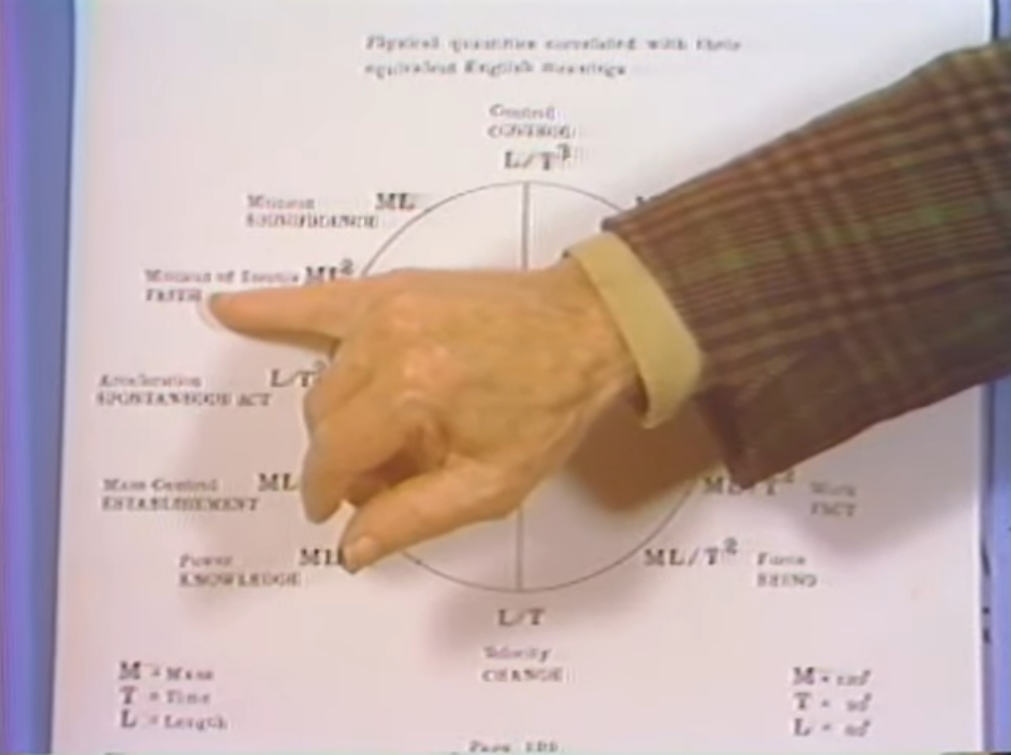
The one that was opposite that... You remember the projective one was at the top, but the information coming from the triangle to the knower which was at the bottom, that was fact. That's why I called this one fact. The triangle has a dent in it or something particular about this triangle that's fed from the object to the knower.
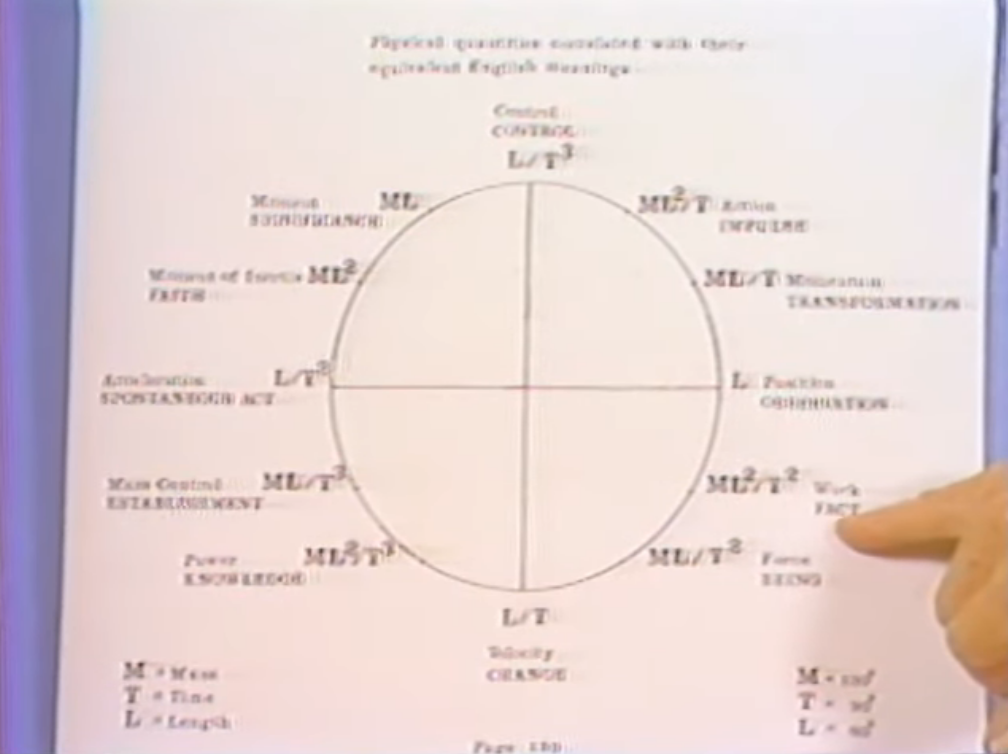
It almost always involves some work because you have to look carefully, or you have to do something, to find what the facts are, whereas the belief is inertia. You just let go what's in you.
We can think of each of these as having a positive or negative value. For instance, if something was completely false, not factual, we would normally think that's negative. But on the other hand, if you're writing a novel, and it wasn't made up -- it wasn't created -- then you would say, well this is simply a description of a life occurrence, it isn't a novel. So the word novel implies that you've made it up.
So in one case this is to be, in other words, the negation of fact is positive here, and this (fact) is the negation of belief -- the fact contradicts your belief.
I hope I'm not getting too complicated with this jumping around. But, you see, we're trying to talk about a whole lot of things at once and if we don't jump around we wouldn't get the real meaning. The meaning comes from the interrelationship of these things. And what we now propose is that with these English words we have a complete vocabulary that tells you the same thing, but in terms that we can understand, or terms that can be applied to people, that the measure formulae did for physics.
Now what we have to recognize is that physics came by these measure formula the hard way. It began when Galileo was measuring the rate of falling of bodies and rolling things down inclines and when Newton was carefully computing the motion of the planets. These measure formula were born, and they were carried along and gradually evolved as the complete vocabulary of the physics of moving bodies.
Now people would say well what's that got to do with life or with life as we live it or with human affairs. Well what I've discovered is that it has a lot to do with it. Let me go back to our original diagram and erase in your mind these ones I've added and just think of those, the original four.

This one which is the position -- remember the pendulum. Now the position is something you see. You could take a photograph, a single photograph. It would show the position. To get the velocity, you have to take two photographs and measure the distance between -- the distance the object has moved in the interval between -- the photographs to be able to estimate the velocity.
To find the acceleration you'd have to take three photographs. Now let me illustrate. Suppose I take two photographs, and in one, the object is here and the next one the object is here. You say well it's moving in a straight line through those two points. But it might be moving in a circle. A circle could go through those two points. You've only taken two pictures, so you really don't know whether it's accelerating, that is to say, going in a circle or whether it's not accelerating, which is going in a straight line just from two pictures. So to know that it's accelerating you have to take three pictures. In other words, if the picture was one, two, three, then you would draw a circle through those three points and say "Well it's accelerating in a circle of such and such a radius." It could be a car with a wheel -- the steering wheel -- stuck.
To know that it was under control you'd have to take four pictures, because if they went one, two, three, four, (following an arc) so the fourth point was still on the same circle, you say well that person's going in a circle. There's no evidence of control -- maybe the wheel is stuck. But if it went one, two, three, four, (following a sine wave) well that would be a line like that. In other words somebody's changing the steering. This would be the case even if he just went around a corner and then straightened out again. That means that the control is being exercised because the acceleration is changing.
Well I want to stand back from that now and, as is my custom, look at a deeper significance, because so far I've just been talking about what the physicist measures and deals with.
I started by saying that we see the position with one photograph. With the velocity, I have to have two photographs and I have to compute the velocity. There's no instrument that directly measures velocity even the odometer or the speedometer on a car, to do it accurately, it has to count revolutions per unit of time. In other words it has to make a computation to arrive at velocity. So velocity involves something more than just seeing. It involves computation.
When we come to acceleration, while it's true that you can formulate acceleration as the rate of change of position -- the rate of change of the rate of change of position -- acceleration is directly felt. Suddenly the elevator (moves). We just had an earthquake the other day. You feel it in your bones if you go down an elevator too suddenly. You feel it in your stomach. In fact you're always feeling acceleration, that's how you're able to stand up. These canals in the ear are very delicate apparatus, senses any acceleration that would tell you when you're tipped.
In other words you feel acceleration, you compute velocity, you see position.
Now here are three outstandingly different faculties epitomized in these three measure formulas. So this is not something that's just going on in physics. It's something that's common to all our experience. In fact, in this I believe we have the roots for the difference between seeing, knowing, feeling, and the one that I haven't talked about, which is action.

Action as this one up here -- or this one here -- there's a distinction between them, but for this purpose I can put these two together. The control is, remember control was not used by Newton or by other scientists because that came from outside the system. But it's because of control that we can use a car. However you can't -- there is no way to anticipate what the control is. That is up to the option of the driver, and that's the whole virtue of control, that it's the free element among these four. It's the one that's optional. That's what makes it possible to control these machines. We've given it status by showing what its measure formula is. But giving it a formula doesn't mean we can predict it.
So summing up then, we have a sort of preview, in physics, of what become the four faculties and this is another foreignness that I didn't mention earlier. But Jung, the psychologist, made a great deal of use of what he called the four functions. He avoided the word faculties because he felt it had been rather abused by previous psychologists but, making that concession, the four functions of Jung are: knowing, sensing, feeling, and intuition.
Now I think the best set is back to our original diagram. The knowing of the definition: "the concept of a triangle." The feeling: "I don't like triangles." The sense data, the sensation: "This triangle has a dent in it." The intuition: "I will use triangles to represent Father, Son and Holy Ghost." You see you can't anticipate what this purpose will be, but that represented the four faculties, and trace their origin in the measure formula, in these things:
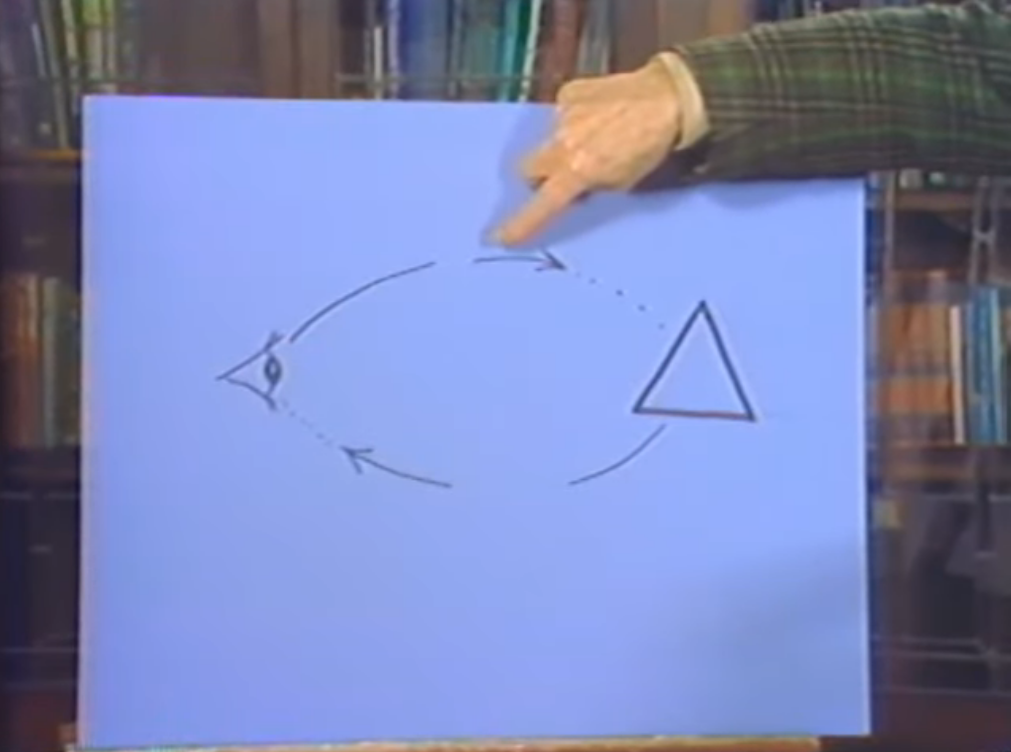
That takes us back, we can now go back to the Rosetta Stone and see what it's really talking about. It's saying that there's an English vocabulary which corresponds -- point for point -- to the vocabulary of the physicist, and the English words have very much the meaning of the physicist's words but sort of broadened out.
I'd like to play with it a little. Why is faith like moment of inertia?
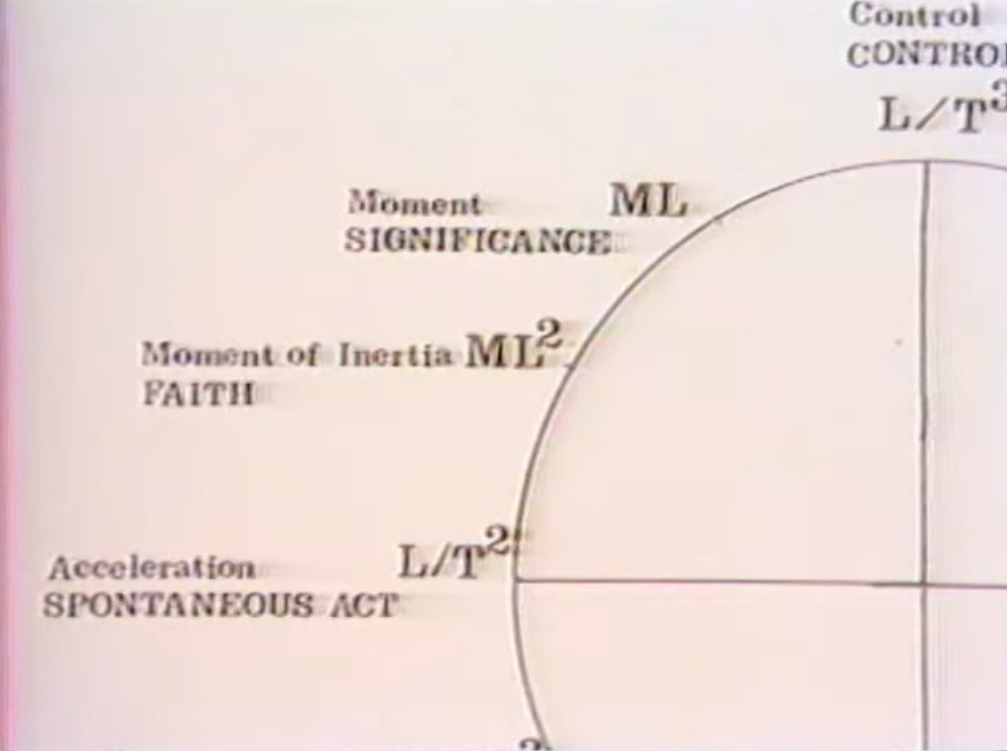
Well faith is what you have to have when the going gets tough. When there's no -- when your push gives out, you have to have faith to keep going. That's exactly what the moment of inertia does. If a car didn't have inertia, or the flywheel wasn't there, then the car would go by a series of jerks as each explosion occurred. It's because of the flywheel, because of the inertia of the car, that you get smooth motion out of jerks. Faith is very valuable in just that sense, that it tides you over the bumps. You see at the same time, faith is opposite fact. In other words, as the Irishmen define faith: "Oh sure, faith, is believing what you know ain't so." The facts might be otherwise, but there are times when you have to have faith, and run counter to the facts, so it's called in psychology counterfactual. In other words, when you learn some principle and get it sufficiently -- have sufficient faith in it -- that even when the principle seems to be denied, you have faith and go ahead.
Now knowledge is not the same as inertia, and it's not the same as work, but it's through knowledge you're able to translate this into this. This (knowledge) is what mediates the inertia. But there's one more principle that's necessary and that's this one that's opposite to it: action.
That's the one I haven't talked about. It's really the most important in the whole picture. Action corresponds to making a decision. You see, it's opposite knowledge. It also corresponds to intuition among Jung's four functions. It's sort of jumping to the answer without having reasons. Remember Sikorsky's little picture, emblem on the helicopter, and the emblem shows a bee, and the script says, according to the theory of aerodynamics the bee can't fly, but to bee being ignorant of aerodynamics goes ahead and flies anyway. That's what is the virtue of this principle. It's the opposite of knowledge. It's ignorance but it's the power of ignorance.
Knowledge is, so to speak, the inert thing that cancels the energy of curiosity.
I suppose people will eventually learn that teaching is not so much giving people answers but encouraging their curiosity, and a similar reform might be applied to... whatever it's called... social welfare. The idea of social welfare is generally that you supply goods to fulfill people's needs. But the whole principle of evolution is based on creating needs. It's through needs that people exert themselves, so if you were to fulfill all needs you'd stop the wheels of evolution. However, that's just something to think about.
I'm illustrating how these so-called negatives, that is, lack of knowledge or ignorance, is a power. And the lack of goods creates the energy or need. This would be need over here (faith) and this the actual object (fact).
Now that completes the English translation, but there's further dividends here because we can recognize that this 12-fold division of the circle is nothing other than the zodiac itself, the famous zodiacal signs. And the simplest way to get into that is to think of the months of the year. This is spring, when the growing things burst into life, the beginning, the first burst of energy of spring.

Then as spring gets underway, things start growing, and by summer, they're at maximum rate of growth.
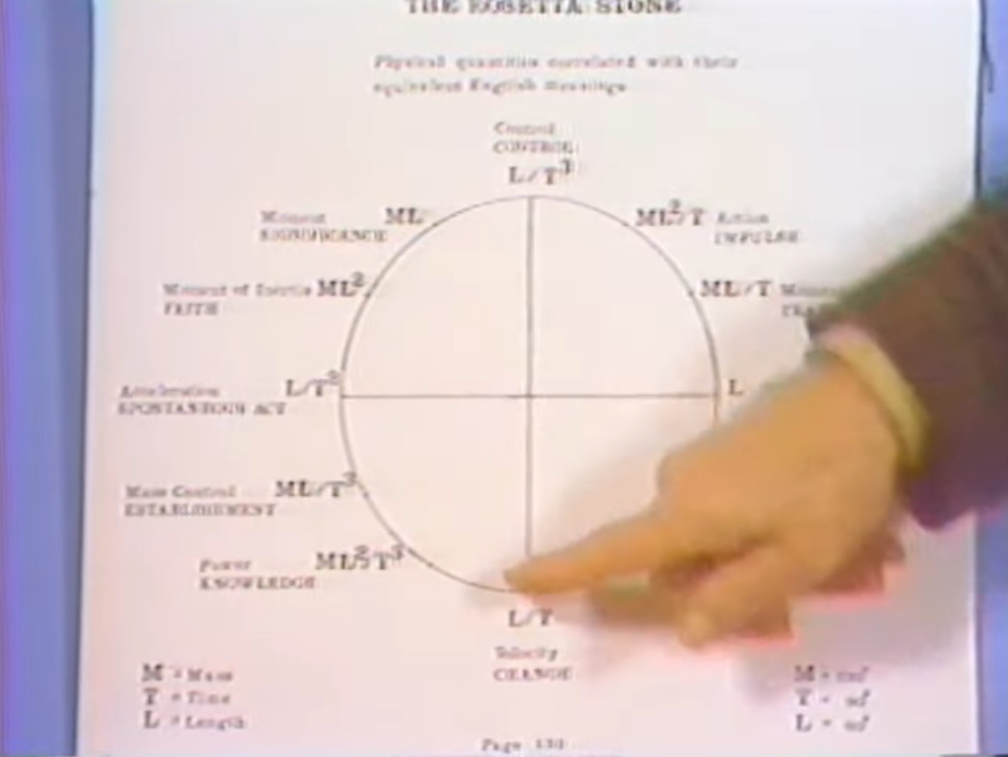
By fall the growth has stopped.
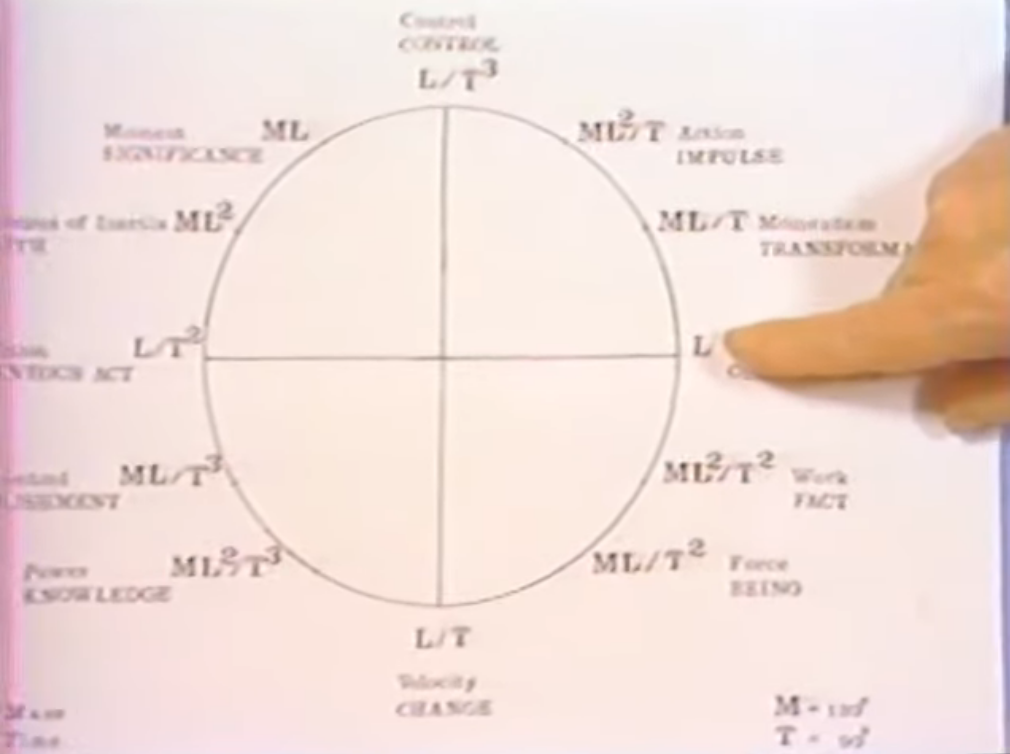
This is going the other direction we're slowing down and looking at to see where we are and at the middle of winter we have to control our resources and be very careful.
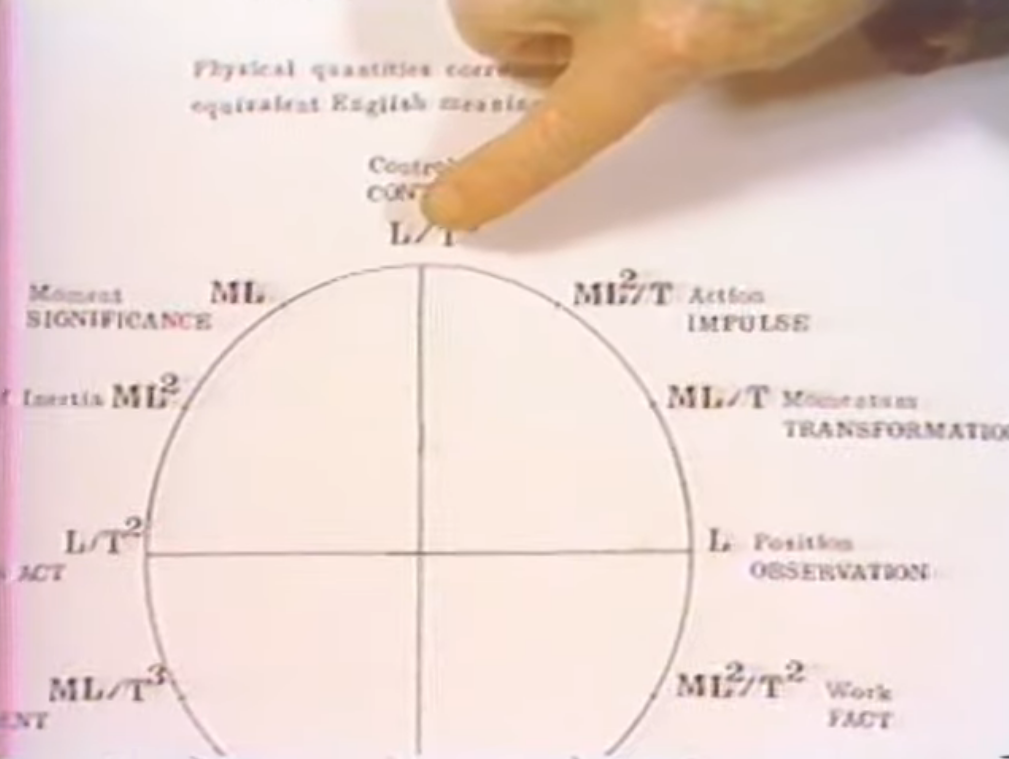
The other signs you can recognize, whether through the season or through the months. This is Taurus, establishment.
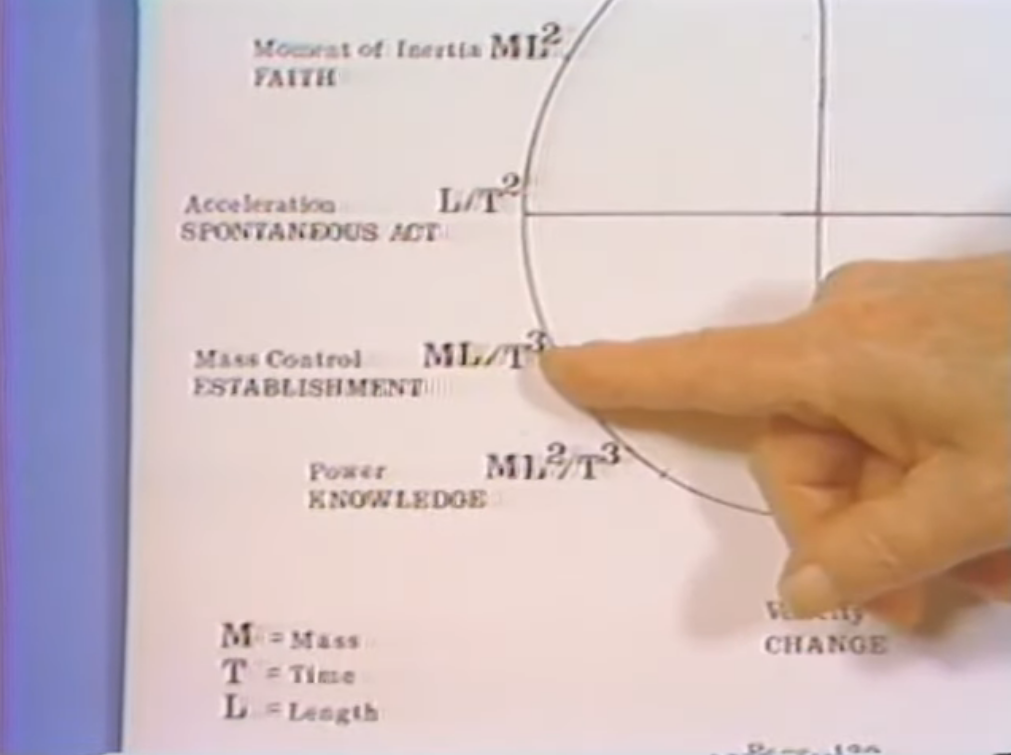
Gemini, knowledge, or power. Cancer, which is change. It really helps to have these key words, because Shakespeare said that "he was born under the crab, sir, all his affairs move sideways." Well the crab moves sideways, and that's the key to this kind of change. You see it is sideways from the point of view of the original thrust, which was this way. This is now this way, at right angles to that. That's the way it was intuitively felt -- intuitively felt as sideways -- and why people selected the crab to represent it, because the crab wiggles along sideways rather than forwards and backwards.
Then we come to Leo which is force, or being.
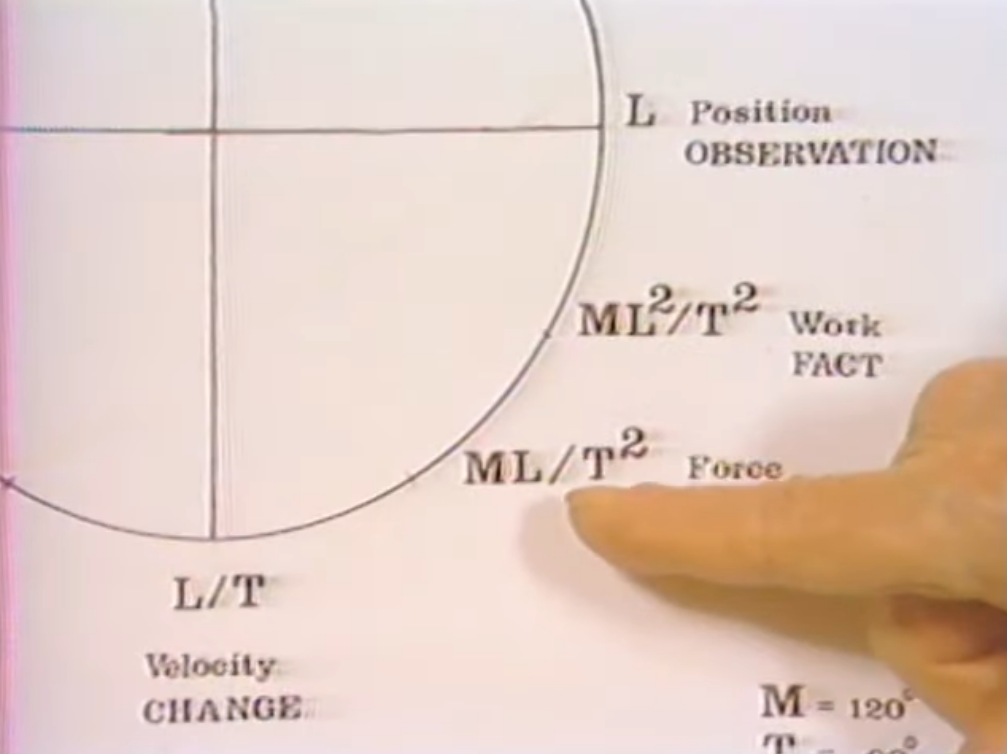
Of course Virgo is well described as work. Libra is position, Libra the scales. You're looking at the scales and making a judgment you're seeing what the position of the scales is.

Here's Scorpio, momentum, transformation. And here this very important one, action, impulse, that's Sagittarius. That's the power of ignorance. That's why Sagittarius is related to gambling but also to higher philosophy because you're guessing, you're jumping in into areas where you're ignorant.
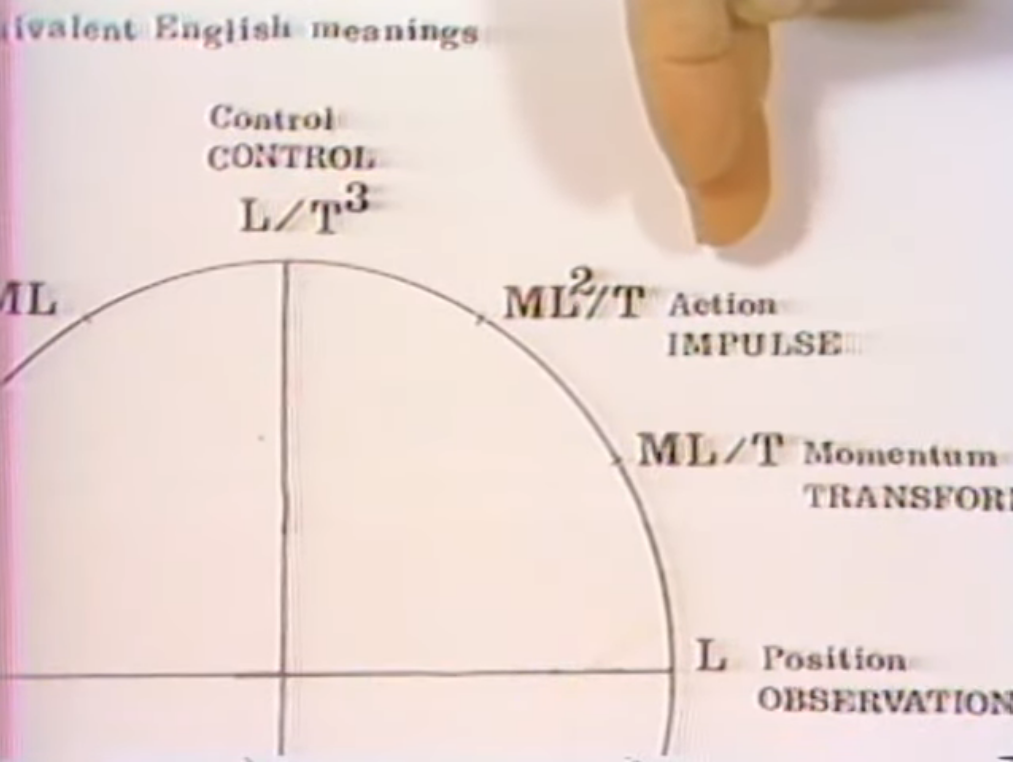
Now of course when they come to here, this is Capricorn, famous for its controlling the situation and the sure-footed goat.

Aquarius, significance. That's a very good definition of Aquarius. It has to do with principles, the opposite of being. You see here the being is the actual force of being, whereas this is a significance in a sense it's non-being. I always think of, well, the unicorn is a representation of this sign, this type of mode of being. Why? Because the unicorn has this horn -- unicorn, one horn -- it starts out as two horns, but they curl around each other and come to a point. They point. They focus right on the issue and this -- that's what this is -- significance, focus.
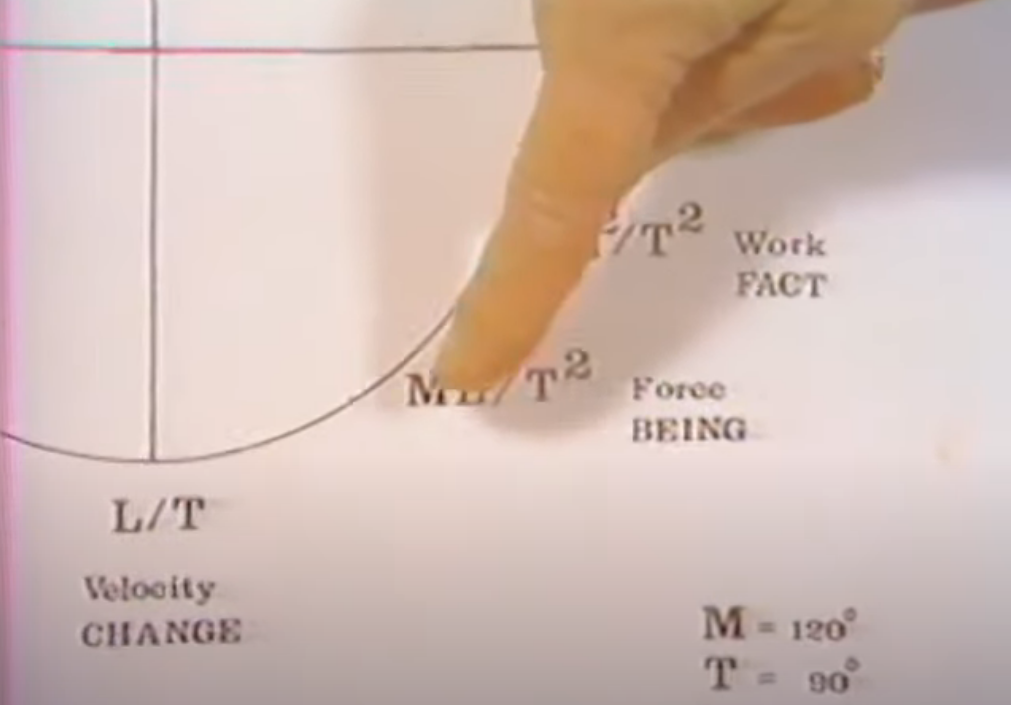
It's the opposite motion to what you have here, we call it being, or Leo. That's the sign of the sun. It means radiating out. The sun is always shown with these rays going out, that's the being. It radiates outward. It's centrifugal, whereas this one is centripetal. It's getting to the point, coming down, focus, significance.
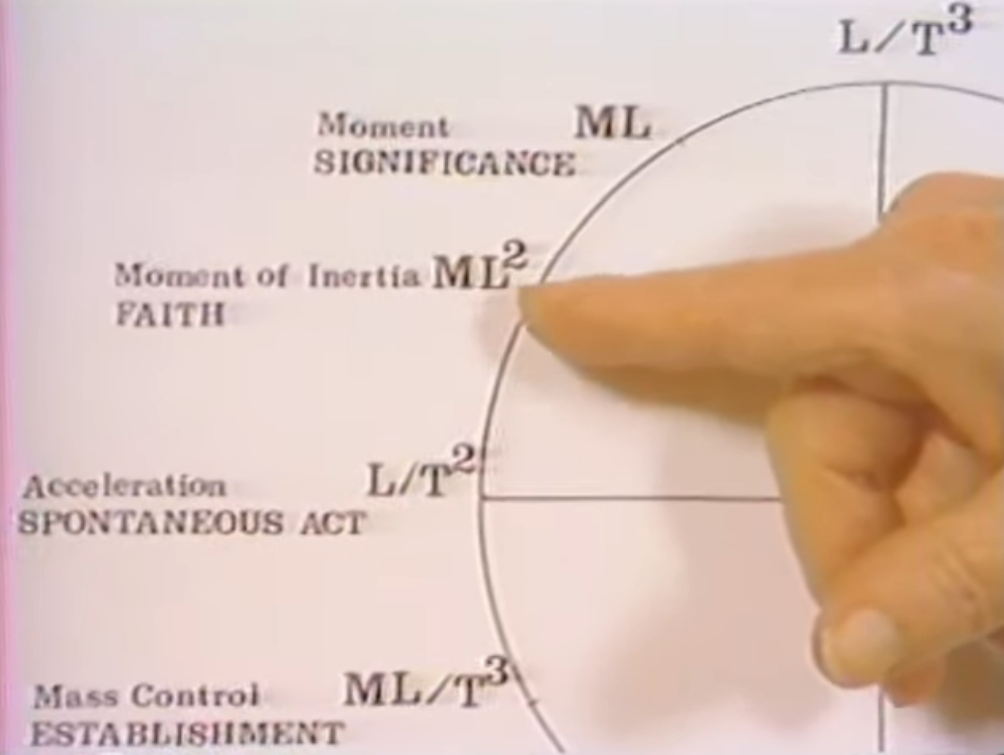
The only one left is Pisces, faith, inertia. See we're in the Piscean age. The age of faith. I can't resist the comment that the age of faith -- faith normally suggests religion, how come we're inside the scientific age -- now, well it's -- science has become the religion, and most people -- and I might even say most scientists -- have a faith in science that won't permit them to recognize, say, the facts of ESP or other facts that would falsify the hypothesis of science. The Piscean age, therefore, turns out to be religion in spite of itself. Despite science's effort to get away from religion, it turns out science is just as Piscean as other religions. It's a faith.
Well, that wraps up the Rosetta Stone and I think I might call attention to something I've skipped. I was trying to get along with this and I left out what I call in the book three-ness. The three-ness is essentially this jump from number one here to this one which is mass times that first one then to here. So if I took my pencil, if I finish out this triangle, I think of these three things. Now that's taking one from each of these sets, you remember: the L over T square, the ones multiplied by M: ML over T square, and the ones multiplied by L.
Now you have to notice that when I made this, first I multiplied by L. But if I'd multiplied by L divided by T. No, if I multiplied by LT, I'd get to here. In other words, this three. It really means that these sets aren't on the same line. They're on the same line from the point of view if I multiply by L but if I want to keep them in sets of three I have to jump one row and look at these three together.
In terms of astrology these are the three fire signs: Aries, Leo, and Sagittarius. Similarly these three are the three air signs Gemini, Libra, and Aquarius. These three would be the three earth signs and these three would be the three water signs. If I put it all on it gets kind of mixed up.
These three go together and this is what I left out in my account.
See when I described acceleration, position, velocity, I was talking about the things that are at right angles to each other. In a sense this isn't the most natural way for them to occur. The most natural way, the free-flowing way, is the way they occur in life. For instance, you encounter a stimulus, you do an act, and you get a result. That's jumping by 120 degrees you go around this thing in three steps. That's one of the reasons that trine is so much easier in an astrological chart. It's a signature of easy flow from one thing to another.
Well let's think of the threeness then by itself. Suppose I walk through the door, naturally to get to the other side. Everything's all right, but if the door happened to be locked, I couldn't walk through the door. Or suppose I pushed the door and it didn't respond. Then I stand back and and look at it and see the sign saying pull, so, rather irritated, I pull the door and get through.
Now the first act, where I went through the door without any trouble, would be an illustration of threeness. The second where I have to stop and think is an illustration of the fourness. See if I went through the door I'd go boom-boom-boom. But if I have to stop and look -- this is the looking this is the changing -- I have changed my technique. Then when I know how to change it then I control the door and open it but it's taken all this time to learn how to open the door.
So the fourness comes about when you have to learn something, the threeness is what occurs naturally.
Now we're ready for another big step and then we'll close the Geometry of Meaning. I've been using this Rosetta Stone in a way that must have appeared to get more and more complicated. Now I want to put it all together and use it and you will see that it will become very simple.
This is a way of spreading out, you might say, all the information you need. But as with any spreading out of information, what do you do with it? Well for this I need another diagram we recall that the Rosetta Stone started with this fourness to which we added the threeness and the three times the four gave us twelve.
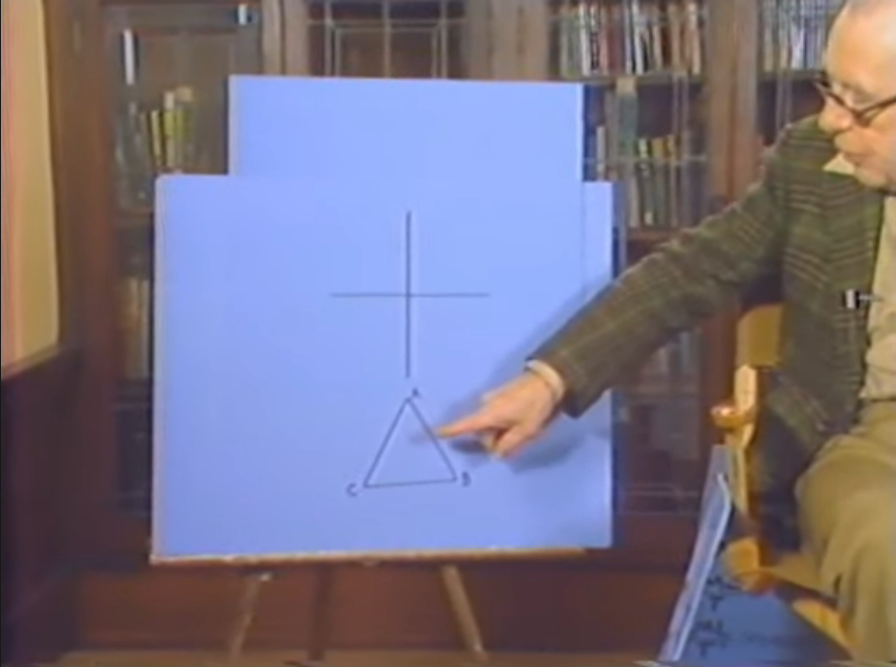
Now let's go back and think about, let's say the problem going through the door. The difference between the threeness, which was the natural stimulus, action, and result, where there is nothing to prevent you going through the door, versus having to learn that the door opens by pulling rather than by pushing which is a four-step operation.
Now suppose you've learned all that. How this is also the problem of explaining life, it's the same problem that the turn introduces in the reflexive universe: What is it that happens when you've got all this twelveness figured out?
I use the story in the Geometry of Meaning taken from Charles Lamb about how cooking was invented. It seems that barns were struck by lightning and burnt down and sometimes some of the pigs got caught in the barn and the result was roast pig. Then people found that roast pig was much more delicious than raw pig, so they burnt down barns on purpose to roast pig. And then they found they didn't have to make such a complicated barn they could just make a fire and roast the pig in the fire.
Well this seems very elementary but it actually is very complicated from a mathematical point of view, from the physicist's point of view. Because what's happened is we've reversed cause and effect. See the the the fire causes the roast pig, but somebody thought and said: "Well if I want to roast a pig I have to make a fire." Now in that case, he thought, the roast pig was the first thing that came to his mind. And it was the roast pig or the idea of getting roast pig that caused him to build a fire. And then he got the actual roast pig. Do you see the sort of V-shape there? We go from fire, cooking imaginary, to an actual fire, to cooking real.
And this is somewhat the same process we were involved with in the theory of process, that purpose finds means to achieve its goal.
But the difference between cause and effect and inference is what makes the difference between the left and right hand side of the ark. The left hand side of the arc is committed to time's natural flow: Cause precedes effect but the other side, where you think what you're doing, the effect precedes the cause. Really what I mean is you use inference on the right hand side. You infer that the fire will cause the cooking. Another illustration: in actual fact, a fire causes smoke. But then you hear the expression "Where there's smoke there's fire." From the smoke you infer that there is a fire and that's the opposite direction to fire causing cooking.
Well to simplify to carry on then, how would we represent natural order? It requires that there be three things, like A B and C. Because you can say the order is A B C. You can then indicate the reverse order by saying A C B. Now this would be illustrated by A B C but the reverse order would be A C B. Do you see one this one goes counterclockwise and this one goes clockwise?
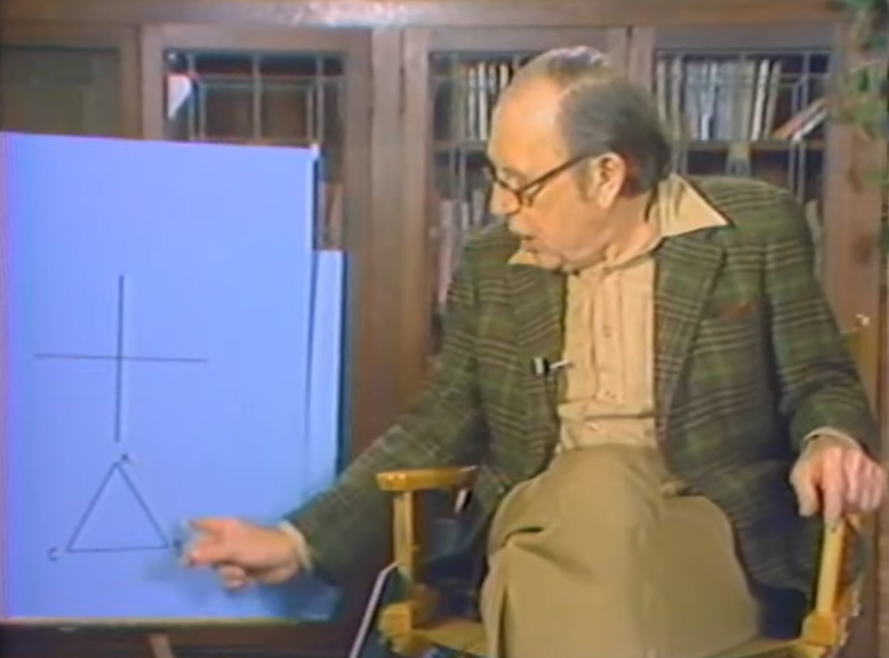
Now recall, well it I didn't give it today with the Geometry of Meaning but I've mentioned it elsewhere -- the cycle of action -- begins here and makes a mistake learns from the mistake and then is careful.
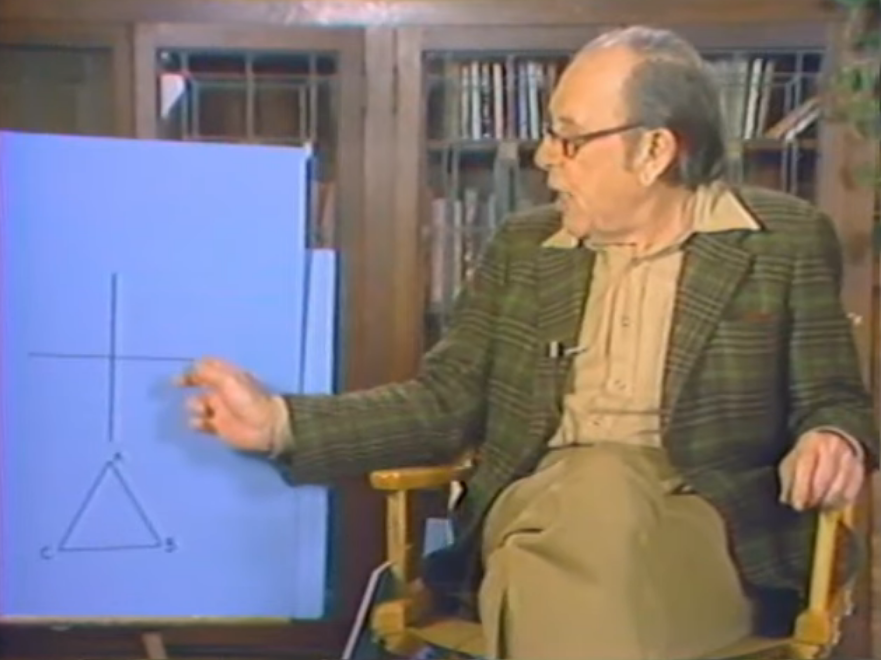
But if you proceed in the opposite direction, which gives you this diagram, in other words, you start at one, learn how make a mistake, think about it, and then control your action.

... And instead of going on to a new new level of action, letting this knowledge become unconscious, you start to apply your action, you go in the reverse direction. That is to say, you you begin by going counterclockwise, you turned and went clockwise. This would be cause and effect this would be inference.
Now those two motions, cause and effect, and inference come about because you have this threefoldness which you can turn either way. It's what I call the zero dimension of choice: the capacity to choose to go in either direction.
This is how intelligence, propositive intelligence, can use the Rosetta Stone, or the formulas, or the knowledge that it's acquired, how it applies this knowledge and regains the freedom that we discussed in The Reflexive Universe or The Theory of Process.
That is very simple but it's somehow subtler than anything I've ever found in the physics book. Let me try to explain it in terms that might stand up to a logician. I'm partly remembering Hume. Hume was a philosopher who startled the world by saying "We have no evidence of cause and effect." We have to assume it. He was thinking of the world in this logical sense, that the cause and the effect are related, but the time sequence can't be logically expressed. The time sequence is a matter of our inner experience not something out there. Time isn't out there.
At any rate Hume had such made such an impression on philosophers that I think this is the place to take off with our argument, because it really involves this point raised by Hume, that we can't know cause and effect by science. We have to infer it. Well I don't agree with him. But that doesn't matter. What is the point? The point is, that in the mapping, that you make of relationship there is no way to distinguish which is the cause and which is the effect. You simply say that these two things are interconnected. You don't have time to order them in one way or the other. The time ordering comes about through this threefold. And it's through the threefold you can distinguish between going from cause to effect, or from effect to cause. It's the difference between turning this way and turning this way.
See cause and effect really doesn't quite... you need three terms to make the distinction. I think stimulus, action, result, are the three terms. And if you do it the other way around, instead of A B C, you go A C B. In other words, the static picture which the intellect presents, which is represented by the fourness, which is a mapping of interrelationship, needs the motion picture, the moving, the time picture, which gives the ordering and tells you which comes first. This also explains the ark. I'm referring to the theory of process; the difference between things falling, coming about in the natural order, for example, entropy.
One of the laws of thermodynamics is the law of entropy, that order gradually gets more and more distributed. Stones roll downhill. Warm, hot things get cooler and cold things get warmer. Things tend to average out. That's known as the law of entropy and it's one of the laws of thermodynamics. But when a plant grows it violates the law of entropy. Not only is it storing energy -- whereas the law of entropy says that energy gets dissipated -- but it's building up. The plant gets higher and higher and higher. It's like a mountain building itself. Of course a mountain couldn't build itself. A mountain would roll down, gradually wear out, but the living thing has this possibility of moving against the flow of entropy.
It's called negentropy and that difference between entropy and negentropy is also the difference between the ordering A B C and A C B. Well I think we can now make a summing up for the whole geometry of meaning. The geometry of meaning is a way of displaying meaning in terms of angles and when we follow it through carefully, following what the physicist does, we get a mapping of meaning that is a very good likeness of the meanings we use in ordinary life. Same vocabulary, turns out to be the same vocabulary that has been used for thousands of years in astrology.
It leads to an understanding of what the whole situation is and through this third step that I've just taken of recognizing that propositive intelligence can invert the natural order and change entropy to negentropy, we can lay the foundation for explaining life. It would take another whole session to explain some of the intricacies of this turn. But I've at least shown the outline of it in distinguishing between the order A B C and the order A C B. So we end up, you might say, we end up returning to natural life. But now at least the formalism can keep up with what we're doing anyway. Thank you.